

Search Smartraveller

Stay safe with the latest travel advice
Everything you need to know before you go
Providing international travel advice for Australians overseas
Learn more about Smartraveller

Travel Advice for Egypt
We've reviewed our advice for Egypt and have lowered the overall travel advice level. We now advise exercise a high degree of caution due to the threat of terrorism. We continue to advise Do not Travel or Reconsider Your Need to Travel to several areas due to threats including higher risks of terrorism or serious crime - read our advice carefully.
Consular assistance
The Consular Services Charter outlines the consular services and assistance provided by the Australian Government to travellers overseas. Read the Charter to understand how we can and can't help.
Consular Services Charter (PDF 195.79 KB)
Notarial services
Do you need a document legalised, or a Certificate of No Impediment for your upcoming marriage? The Australian Government can provide some notarial services.
Travel insurance
If you're going overseas, travel insurance is as important as a passport. If you can't afford travel insurance, you can't afford to travel. Read our advice, and download the CHOICE travel insurance guide before you go.
CHOICE travel insurance buying guide 2023 (PDF 3.52 MB)
News and updates
Smartraveller turns 21.
Celebrating over 20 years of helping Australians stay safe with travel advice.
Highly Pathogenic Avian Influenza outbreak
Several strains of highly pathogenic Avian Influenza are circulating globally. Be aware of increased health risks when travelling to impacted countries.
Mpox global public health emergency
The World Health Organisation (WHO) has declared the current Mpox outbreak in parts of Africa as a global public health emergency. Mpox cases have also been reported across the world. If you’re planning to travel overseas, read more about Mpox to protect your health.
Don’t let a mistake end in misfortune
The latest research from the Department of Foreign Affairs and Trade’s Smartraveller and Insurance Council of Australia shows Australians’ common misunderstandings when it comes to travel insurance.
Travel advice explained
Learn what our advice levels mean and how we decide what level to apply to each destination.
Passport services
With passport demand on the rise, don't leave your application to the last minute.
Allow a minimum of six weeks to get a new passport or renew one.
Coming back to Australia
Know what to do and what expect when you're heading home from your trip overseas.

Before you go...
Subscribe for updates.
Sign up to receive travel advice updates for your destination direct to your email, or manage your current subscription preferences.
- Skip to primary navigation
- Skip to main content
- Skip to primary sidebar
- Skip to footer
TravelAwaits
Our mission is to serve the 50+ traveler who's ready to cross a few items off their bucket list.
What Is The Smart Traveler Enrollment Program And Why Do You Need It?

- News and Tips
- Travel News
As the COVID-19 pandemic continues and many countries post record-breaking daily or weekly case counts, the U.S. State Department now cautions that U.S. citizens who travel internationally may face unexpected challenges related to the coronavirus as they attempt to return to the U.S. or travel from one foreign country to another.
One of those challenges is to simply stay up-to-date on various countries’ travel restrictions.
That’s because governments around the world continue to implement new requirements and even impose new travel restrictions as they strive to keep COVID-19 case counts down in their own countries. The problem, however, is that changes are often implemented quickly with little advance notice, which may take those traveling by surprise.
The good news is that the State Department offers a service that helps U.S. citizens and nationals stay informed about changing conditions in countries they are visiting or plan to visit.
The Smart Traveler Enrollment Program (STEP) is a free service that enables U.S. citizens and nationals traveling and living abroad to enroll their trip with the nearest U.S. embassy or consulate. That way, they are able to quickly receive important information from the U.S. embassy about safety conditions in their destination country, which helps them make informed decisions about travel plans. Another benefit is that enrolling a trip in STEP makes it easier for the U.S. Embassy to contact travelers with important information about natural disasters or civil unrest in their destination country, or to contact the traveler in the event of a family emergency.
Here’s a quick look at what you need to know about STEP before your next international trip.
Created To Assist U.S. Citizens
Consular officers at U.S. embassies and consulates can help U.S. citizens who run into legal, medical, or financial difficulties while visiting other countries. For example, if a U.S. citizen’s passport is stolen while traveling, staff at an embassy or consulate can help that traveler get a replacement passport. They can also provide the names of English-speaking doctors or local attorneys, as well as provide information about dangerous conditions.
“In a crisis situation such as a natural disaster or severe political instability, the Department of State often takes an active role in providing information and assistance to U.S. citizens in the affected area,” the State Department explains . “We encourage all U.S. citizens travelling or residing overseas to notify the closest U.S. Embassy or Consulate of their contact information so that, in an emergency, we can contact them to provide important safety and security information, or support during a crisis. Enrolling in STEP is an easy way to send your contact information to us online.”
In addition to Travel Advisories, U.S. embassies and consulates often send alerts about emerging situations in a country. It’s important to enroll your international trip in STEP because these alerts are written specifically for a traveler’s dates of travel and destination.
You can learn more about the STEP service here and create an account to enroll a trip here .
Know Before You Go
If you are planning an international trip, the State Department has two more suggestions for you. The first is to visit its Country Information webpage so you can learn about your destination.
“We provide safety and security information for every country of the world to help you assess for yourself the risks of travel. Each Country Information page contains a Travel Advisory, Alerts, and other important details specific to that country that could affect you,” the State Department explains. “Pay close attention to the entry and exit requirements, local laws and customs, health conditions, and other details to decide whether traveling to that country is right for you.”
The State Department’s Country Information web page may be found here .
The State Department’s second suggestion is to visit its Traveler’s Checklist webpage, which is found here .
That page includes information explaining how to get informed about conditions in a country you plan to visit and ensure you have all necessary documents. It also provides information about three types of insurance: health insurance, evacuation insurance, and additional insurance for unexpected expenses such as those from interrupted or delayed travel and lost luggage.
While you’re thinking about international travel, be sure to read all of our travel news coverage as well as our COVID-19 coverage, including 6 Things The State Department Says You Should Do If You’re Traveling Internationally and 21 Expert Tips For Traveling Internationally Right Now .

Jim Fulcher has been a writer and editor his entire career. In addition to writing, he also enjoys traveling--particularly in an RV. Over the course of numerous trips, Jim has driven an RV through West Virginia, Virginia, Tennessee, Kentucky, Indiana, Illinois, Wisconsin, Iowa, Nebraska, South Dakota, and Wyoming. His favorite national park is Yellowstone, which he has visited three times.
How the State Department’s Smart Traveler Enrollment Program could help you on your next trip abroad

Editor's Note
Though careful planning and common sense are two of the best ways to stay safe when traveling, security situations can rapidly change in foreign countries.
That's why the U.S. State Department's Bureau of Consular Affairs has created the Smart Traveler Enrollment Program to help keep you up-to-date on relevant security updates from the nearest U.S. consulate, wherever in the world you happen to be.
Here's how to sign up for STEP.
Who should register for STEP?
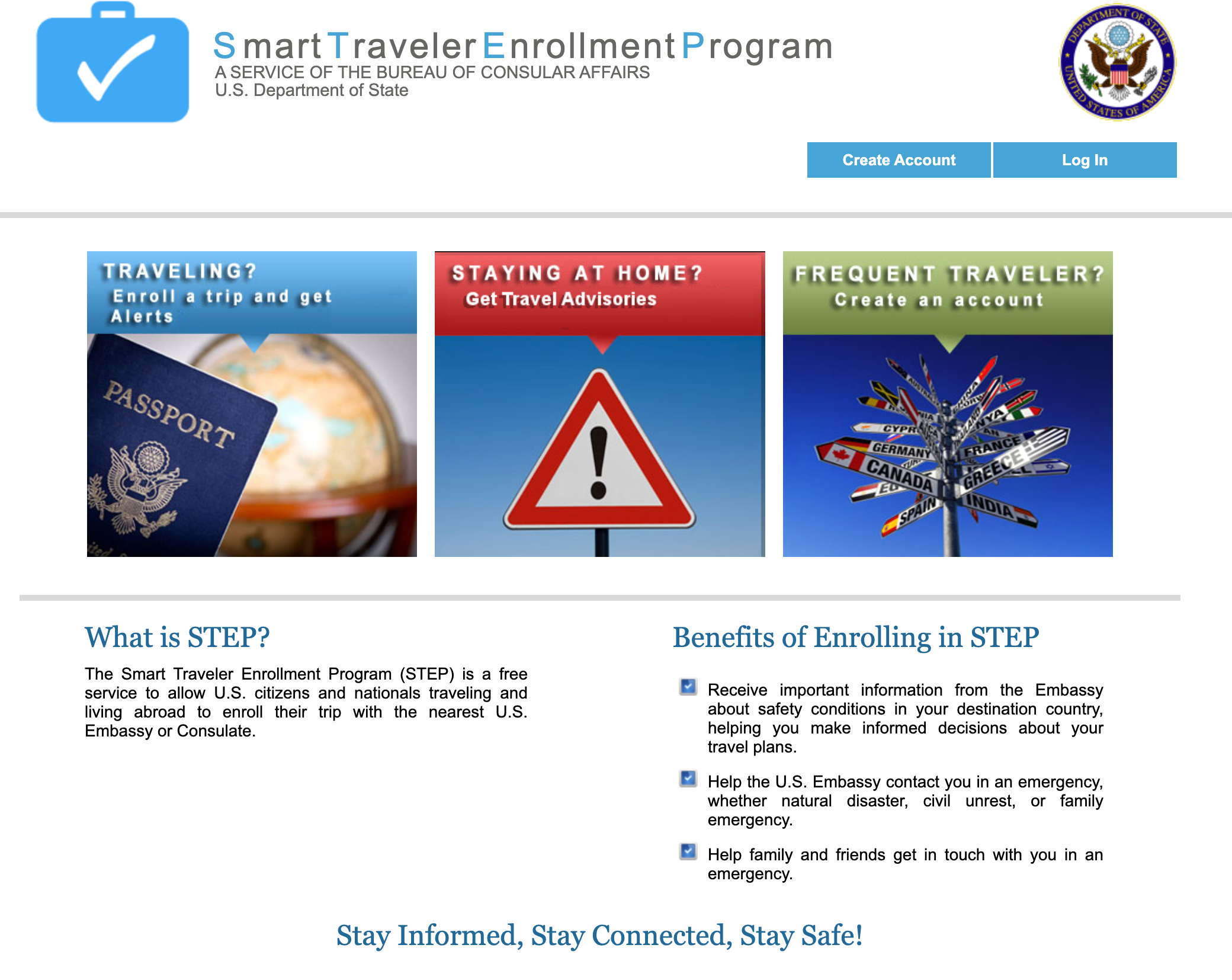
The primary purpose of STEP is to keep American citizens safe. Here are a few reasons to consider signing up:
- You're traveling to an area that's politically unstable or prone to violence.
- You're taking an extended trip (several weeks or months) where you have limited Wi-Fi access.
- You're traveling for a major event, summit or conference (like the World Cup) that might become the target of protests or attacks.
- You're a minority traveling to an area where you might be targeted as an outsider.
- You'd like an additional safety resource during your trip, no matter the destination.
Some group trips or programs may require participants to enroll. For instance, I had to enroll when I studied abroad in college.
In the event of a rapidly deteriorating situation, such as a coup or natural disaster, STEP can connect you with evacuation efforts or provide important safety information and help you take care of yourself.
How to register
To register, create an account and fill in your personal information and emergency contact details.
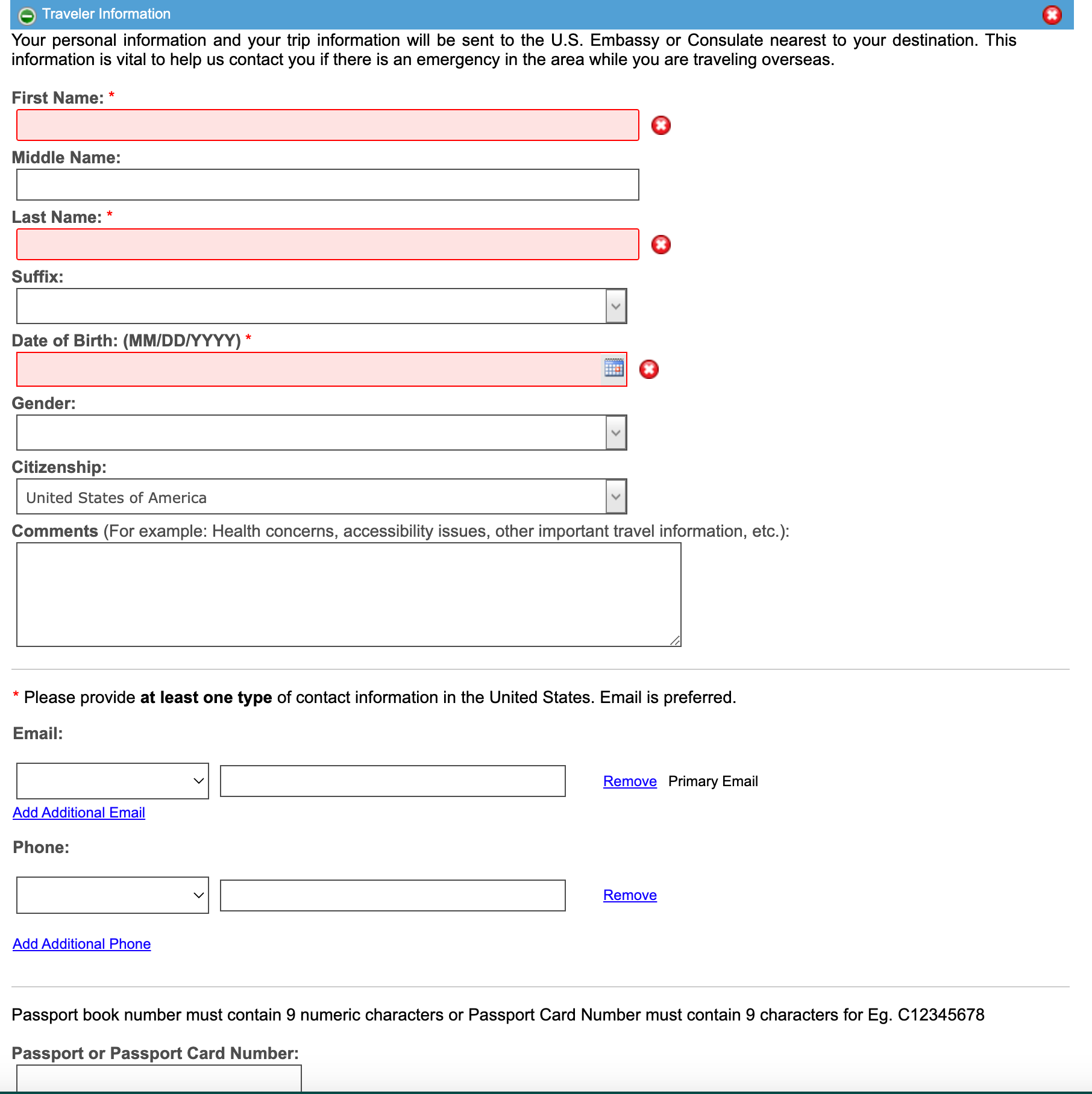
Once your account is set up, log in and register each specific trip or residence abroad. You'll repeat this process for each new trip to receive STEP alerts.
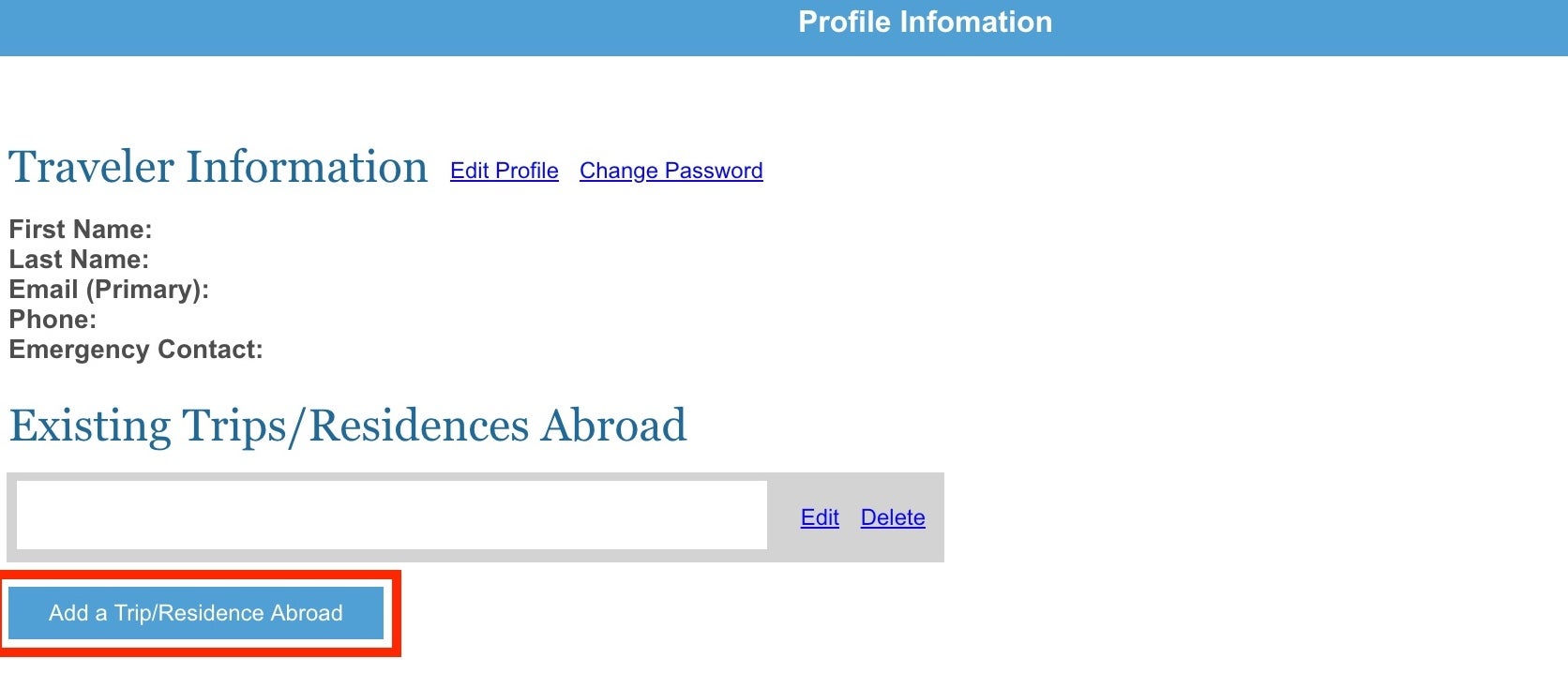
You'll then be prompted to enroll any upcoming trips to receive STEP notifications. Select the nearest U.S. consulate to where you'll be staying. Note that "destination" refers to the country (not a specific city, state or territory), and the available options will auto-fill as you type.
Next, fill in the dates of your trip, the reason you're traveling and how you can be reached while abroad. If there are any timely alerts specific to your destination, you'll also be alerted of that information at this point.
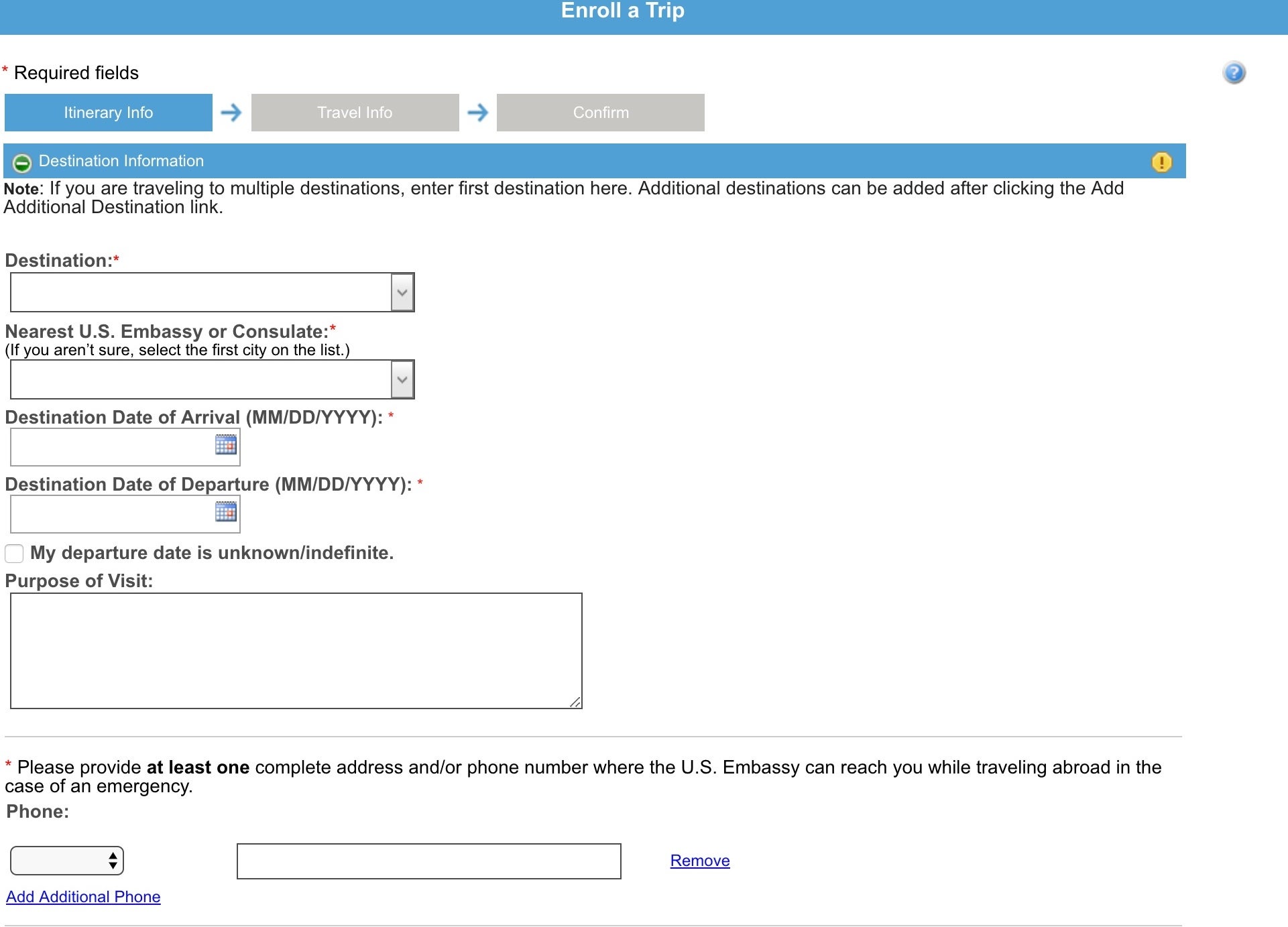
Bottom line
It may be helpful to think of STEP like travel insurance: If all goes well, you won't need to use it, and you might even forget you have it.
However, if things go wrong while you're traveling abroad, your local U.S. embassy is the quickest way to get help; the embassy's goal is to ensure all Americans in its jurisdiction are safe and accounted for. This is when STEP notifications can become incredibly important.
The entire sign-up process takes less than five minutes, and the trip registration process takes about 60 seconds.
For additional resources, be sure to follow the State Department on Twitter and bookmark its international travel page for the latest country alerts.
Related reading:
- The difference between CDC and State Department travel warnings
- Confused by State Department travel advisories? Here's what they mean
- If you need a passport quickly, this service may be for you
- Passport processing wait times decrease for the 1st time since February
- Prepare to wait: Current Global Entry processing times are up to 11 months
20 Useful Mexico Travel Tips To Know Before Your Trip
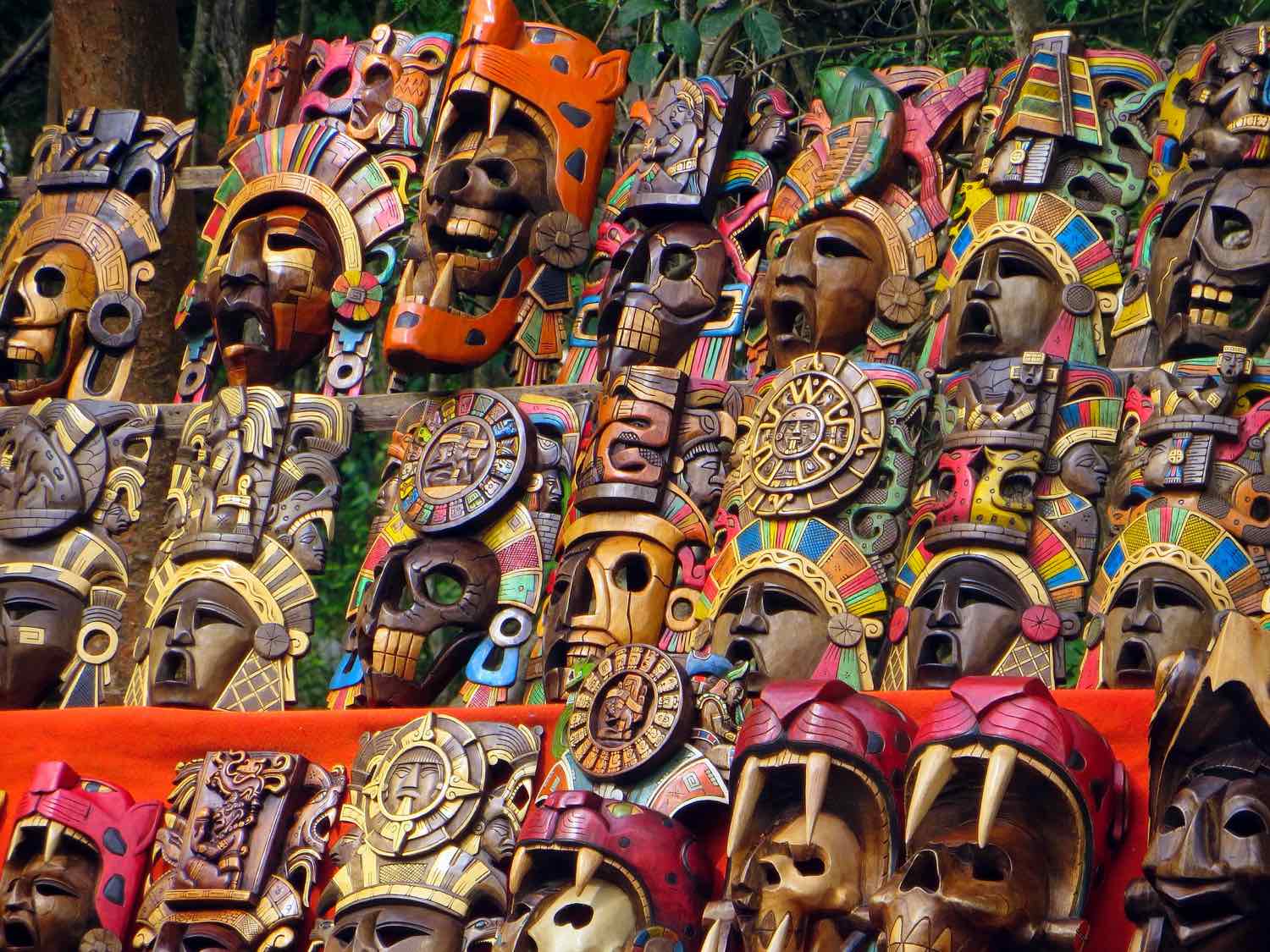
This list of Mexico travel tips is mostly for first-time visitors traveling to Mexico, but it can help anyone achieve a safe and worry-free journey.
Mexico is huge. Even though my itinerary allowed me to explore just a tiny percentage of it, I had a blast and feel I had a balanced mix of cities, culture, beaches, and history.
I did quite an extensive research to plan my trip but it was during the trip itself that I learned a lot. This list compiles exactly that. All the things I wish I had known before visiting Mexico .
🇲🇽 Things to know before traveling to Mexico
- Don’t stress out because of safety concerns .
- Go cenote hopping .
- Pay in pesos, not dollars .
- Explore beyond the touristy resorts .
- Don’t underestimate the size of the country .
- It’s not always warm and sunny .
- Indulge on the unique Mexican food .
- Leave your drone at home .
- Know the Mexican bathrooms.
- Plan for the best beach weather .
- Get around by ADO bus .
- Give a chance to Mexico City .
- Go for the street food .
- Be careful when renting a car .
- Explore the ancient ruins .
- Try to avoid tours .
- Learn basic Spanish .
- Connect with locals .
- Avoid the tap water .
- Stay connected with a Telcel SIM card .
1 Don’t stress out because of safety concerns
Mexico has an awful reputation on media, from drug cartel violence to missing women in the metro. Not to say these things don’t exist.
However, most of these things happen in areas that you’re unlikely to visit. This is true even inside the cities. In Mexico City , the central areas are safe and most of the crime is concentrated in the suburbs. If you follow these safety tips in CDMX , you’ll be fine.
Mexico is in general very safe, with very welcoming people.
Remember roughly 40 MILLIONS of people visit Mexico every year and violence against tourists is rare. The main crime travelers may encounter is petty theft. Be aware of your belongings at all times, particularly in crowded places.
2 Go cenote hopping
View this post on Instagram A post shared by BRUN🌎 (@bruno_mb) on Mar 3, 2019 at 1:07pm PST
I had never heard of cenotes before coming to Mexico and I learned that is so easy to become obsessed with them. Cenotes are cave-like sinkholes or natural swimming holes that can be found all across the Yucatán peninsula.
Some look like underground caves. Others are more like an underground swimming pool. Others are just like a giant open-air pit. They’re very diverse so try to visit at least two or three of them.
The Mayas believed these were sacred portals to the underworld; while this may not be necessarily true, they feel indeed magical.
There are over 6,000 different cenotes in Yucatán , here are some of the most beautiful.
- Cenote Dos Ojos in Tulum
- Cenote Samulá in Valladolid
- Cenote Zaci in Valladolid
- Cenote Ik-Kil in Chichen Itza
- Cenote Azuk in Tulum
- Cenote Suytun in Valladolid
- Cenote Xkeken in Valladolid
- Gran Cenote in Tulum
3 Pay in pesos, not dollars
In some places, especially the touristy hotspots like Playa Del Carmen , it’s technically possible to pay in U.S. Dollars (USD).
However, you’ll get a much better deal paying in pesos because places can choose the exchange rate. When you get to Mexico, take money out of an ATM (never use exchange bureaus!) and make sure you always have pesos with you throughout your trip.
If possible, use Revolut to pay even less fees.
4 Explore beyond the touristy resorts
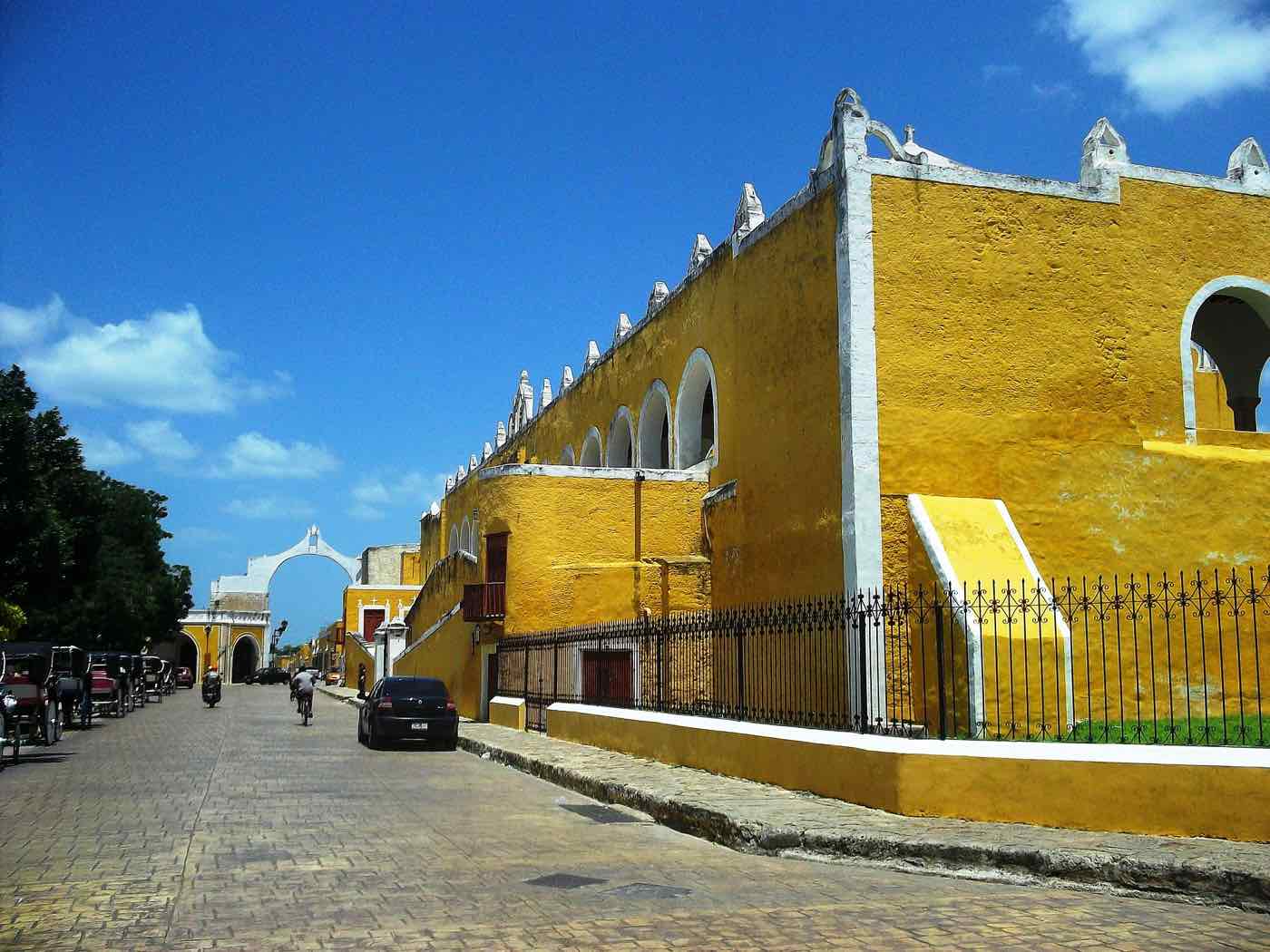
This is one of the key travel tips in Mexico, guys.
There’s absolutely nothing wrong with planning some days at the beach in Riviera Maya – they are well-deserved after touring the country! – but settling for the typical resort all-inclusive vacation in Mexico is almost offensive to the rest of the country.
Personally, the idea of booking a trip to stay at a megaresort in Cancún with some seldom guided tours to explore where locals live is my idea of Mexican vacation hell. All you’ll be seeing is other tourists.
Mexico is a HUGE country with plenty of other destinations you can explore . I skipped Cancún and Playa del Carmen all together for my itinerary and added more authentic colonial towns like Valladolid or Mérida to understand better its amazing sub-cultures.

5 Don’t underestimate the size of the country
In case you haven’t noticed, Mexico is an absolute beast of the country. Spreading out for an area of almost 2 million km² (!) is has more than 130 million people. More than 20 million of them in Mexico City’s metropolitan area, which is also the largest city in the Western Hemisphere.
Getting from point A to point B always takes longer than you expect. Plan accordingly and don’t hop city to city in the least amount of time possible. A key Mexico travel tip (that is universal): slow travel is your friend.
6 It’s not always warm and sunny
Because the country is so big, weather changes considerably from region to region.
In general, the best time to visit Mexico is between December and April. But while may experience some chilly nights in Mexico City as it corresponds to the peak winter season in the Northern Hemisphere. Bring your jacket!
That said, in December and January while is perfect beach weather in Riviera Maya , in places like Tulum or Playa del Carmen . The hurricane season has passed and despite being the “coolest months”, temperatures can still reach averages of 28 degrees Celsius in some places.
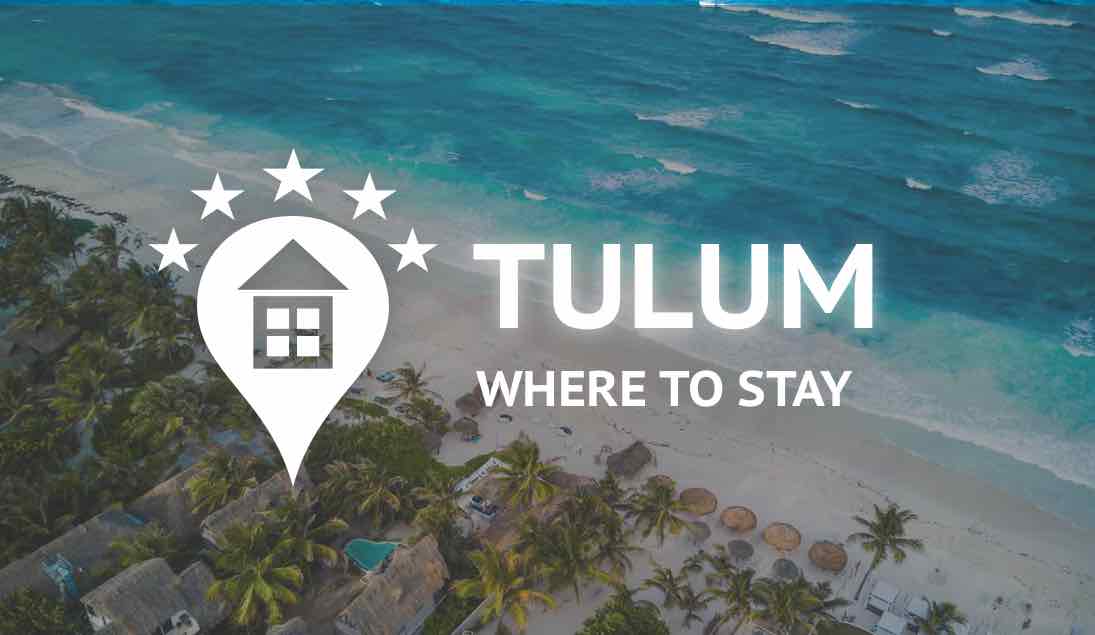
7 Indulge on the unique Mexican food

Forget any diets when coming to Mexico because let’s face it, Mexican food is FREAKING DELICIOUS. Not always the healthiest, not always respecting the 5-a-day rule, but you’ve got time to recover after your trip.
And there’s much more than just tacos , nachos , and guacamole (which is actually not that common!). Each region in Mexico boasts a different sub-culture and that is represented through food as well. In Yucatán for instance, you’ll find a whole new version of Mexican food with origin in the Mayas and that includes chaya , sopa de lima and the popular conchinita pibil .
I suggest indulging as much as you can in the local food and if possible, take a cooking class to properly experience this unique cuisine.
Dishes you need to try in Mexico 🌮
- 🌮 Cochinita pibil: a Yucatan dish consisting of marinated meat wrapped in spices and banana leaves, usually suckling pig.
- 🌮 Chilaquiles : the ultimate breakfast food made with fried tortilla strips simmered in a green or red salsa and usually topped with eggs, cheese, beans, meat or all of the above.
- 🌮 Enchiladas : tortillas filled wth meat, cheese, beans, vegetable or seafood and covered in a chili sauce.
- 🌮 Gorditas : similar to Venezeluan arepas , this is a type of pastry made with masa , stuffed with cheese, meat, or other fillings and served usually fried. It’s not a coincidence they loosely translate as “little fatty ones” though…
- 🌮 Sopa de lima : a lime-infused chicken soup with pieces of fried tortillas .
- 🌮 Tacos al pastor : Mexico City’s favorite tacos, these are meat tacos sliced off a spit and served with coriander and pineapple.
- 🌮 Quesadillas : tortilla filled primarily with cheese, meats, vegetables and/or beans and then cooked on a griddle.
8 Leave your drone at home
If you have a drone and are anything like me, you dream of taking some aerial shots of the eye-catchy Tulum beaches, cenotes or ancient ruins in the forest.
First of all, flying over archaeological sites like Uxmal or Chichen Itza is strictly forbidden.
And it gets worse. A recent law explicitly says that 1) you have to be a Mexican citizen to fly a drone in Mexico 2) it has to be registered. Legally, they’re able to confiscate your drone when you enter or leave the country.
Whether they enforce this or not, is questionable, but I didn’t want to risk it.
9 Know the Mexican bathrooms
OK, so let’s talk bathrooms.
The first thing to know is that the door with an “M” IS FOR WOMEN. M is for mujeres ! Even after living in Barcelona for years, I may or may not entered the women bathroom by mistake more than once.
After you have done your business, you’ll likely find a basket next to the toilet. This means the place is not connected to the public sewage so flushing your toilet paper can cause clogs. Deposit your used toilet paper in the basket.

10 Plan for the best beach weather
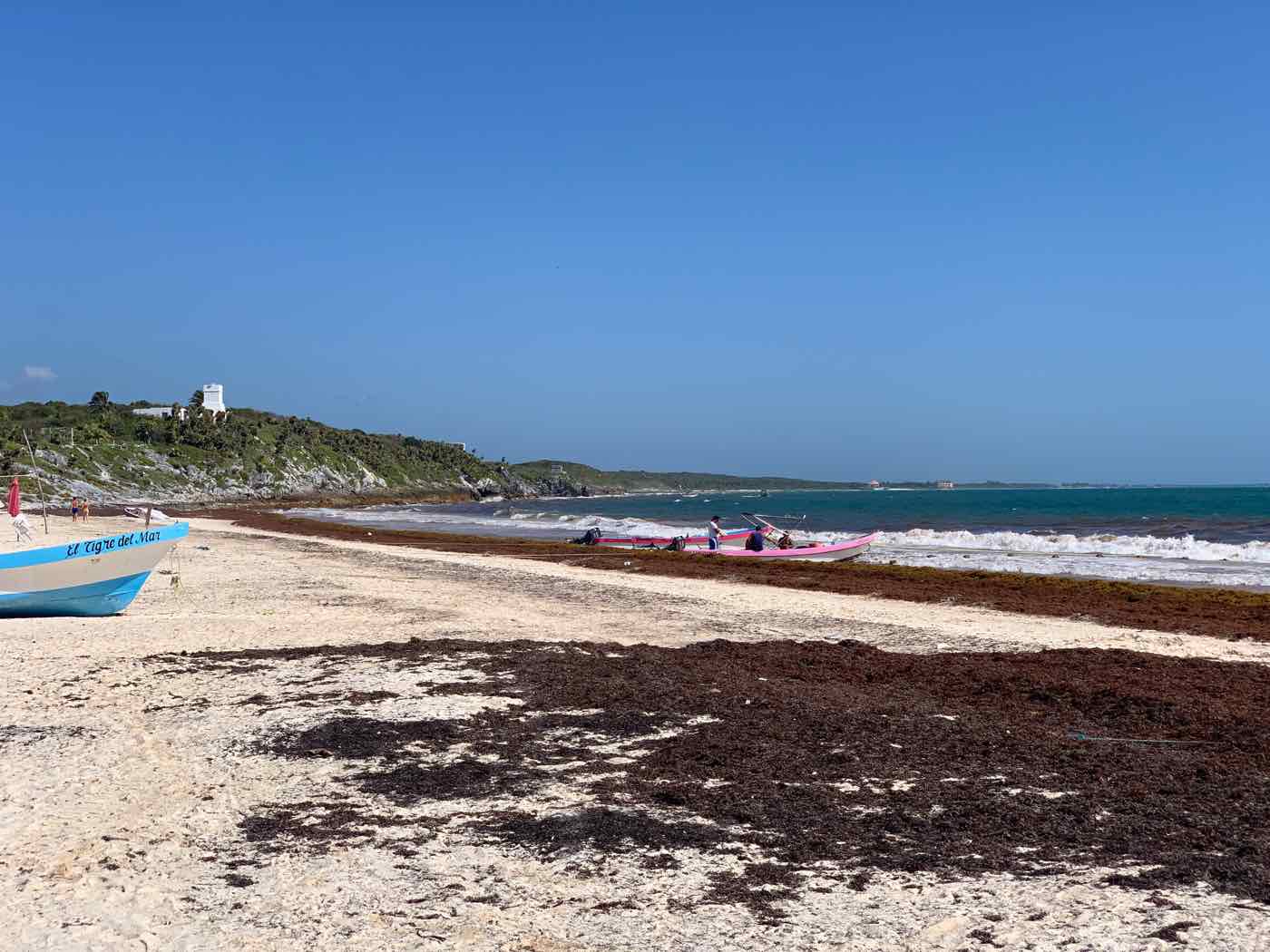
If you’re planning to spend some time at the pristine Mexican beaches, there are two main things to consider.
Firstly, watch out for the hurricane season . Between June and November, hurricanes and tropical storms can impact the weather on the Caribbean coast of the Yucatan Peninsula, the Gulf Coast, and even the Pacific coast.
If you decide on taking a vacation during hurricane season – great travel deals to be made, as crowds are fewer – consider purchasing a travel insurance policy . Be fast. Usually, as soon as a storm is named, providers consider it a “foreseeable event” and will not cover in some (or all the) situations.
The other thing to consider are seaweed (aka sargassum or sargasso ). No one wants to arrive at a soft white sand beach and find out it’s entirely covered in a brown-ish stinky seaweed. I learned about this the hard way!
Sargassum season usually runs from April to August, but in recent years there have been reports of “waves” of seaweed arriving off-season. I visited in March and many beaches in Tulum were covered in seaweed! The scale of the sargasso is so big that most hotels and even the government don’t have the means to clean the beaches on a daily basis.
The Sargasso Monitoring Network of Cancún publishes daily reports of the situation on the beaches of the Caribbean coast, based on satellite and drone images, and even photographs of citizens.
If you want to keep your beach time sargasso-free, stay in a place which has staff constantly monitoring and managing the situation in front of the hotel. This is usually the case with high-end hotels and resorts .
11 Get around by ADO bus
Traveling independently through Mexico is easier than you think. While internal flights are affordable, they’re not sustainable and you can use the trip to see a bit more of the countryside.
ADO Buses are surprisingly modern and comfortable and there’s plenty of routes every day connecting all major and minor towns throughout the country.
Oh, they’re ridiculously cheap too. My trip from Valladolid to Tulum costed 110 pesos (less than $6 USD at the time). You can buy tickets online (only some foreign credit cards accepted) or at the nearest terminal de autobuses (bus terminal).
12 Give a chance to Mexico City.
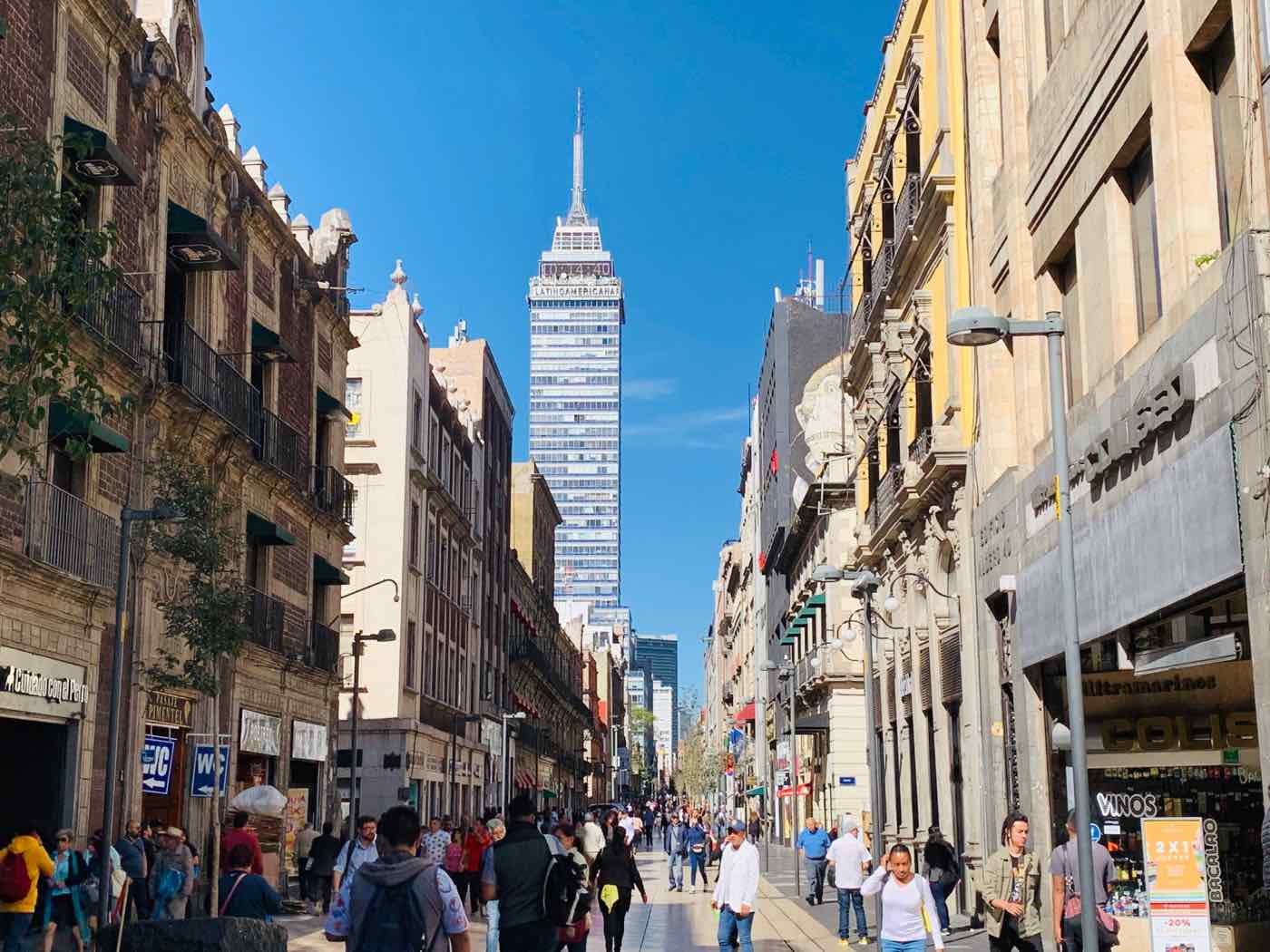
Mexico City is the elephant in the room when it comes to Mexico. People are so formatted to fly directly to Cancún or Acapulco that they overlook this massive, vibrant, culturally interesting metropolis that offers a ton of things to do and see.
Adding it to your trip to Mexico will make it much more diverse and truly feel like a complete overview of this beautiful country. I suggest at least three full days .
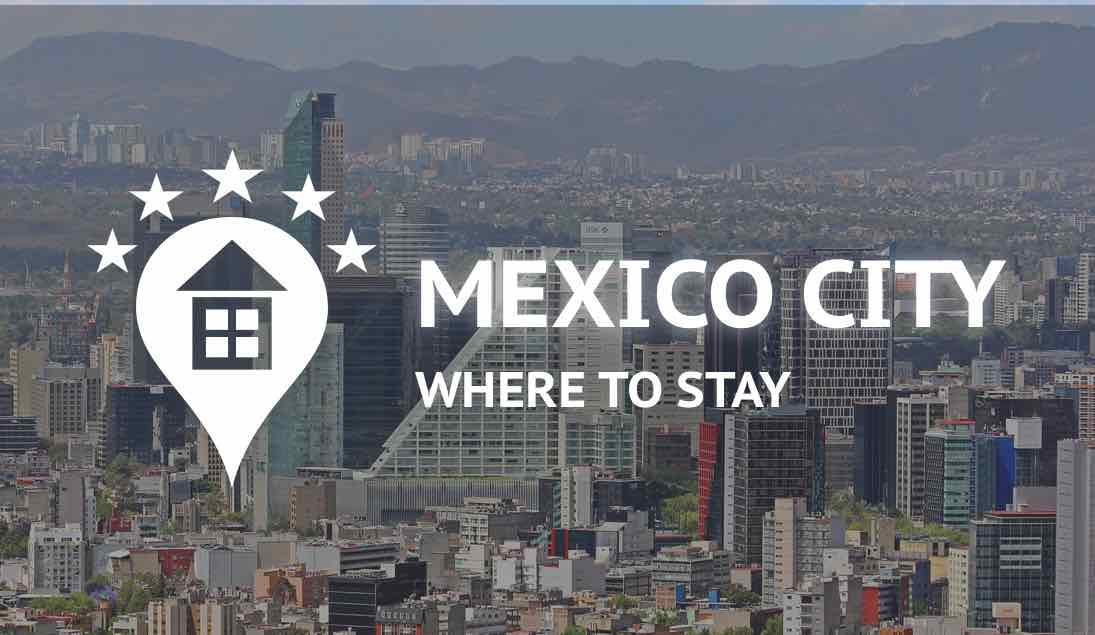
13 Go for the street food
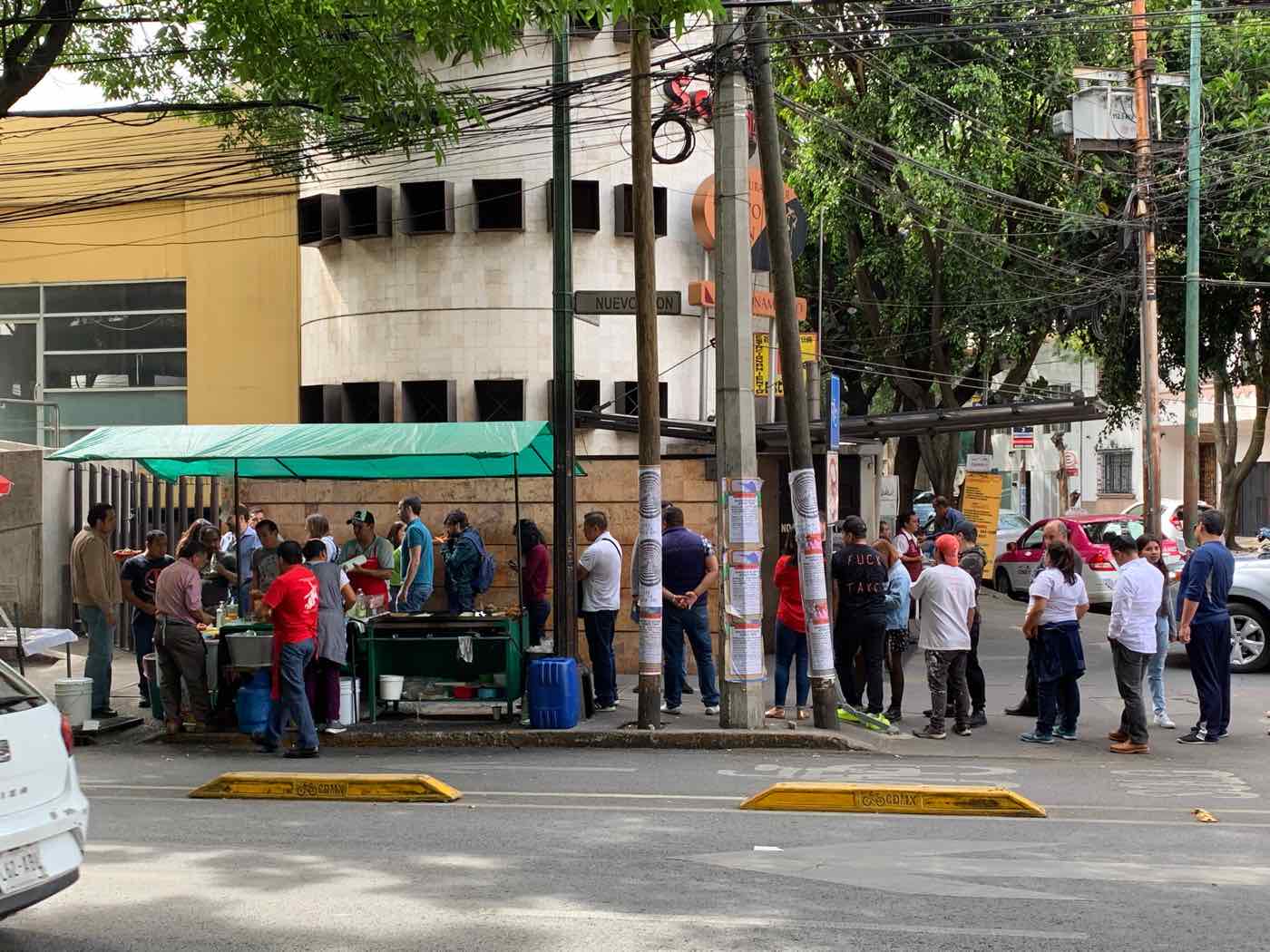
Not trying the street food is missing out on a huge cultural part of any country.
In that department, Mexico is a respectable competitor to Vietnam , where I tasted the best street food ever.
Pay attention to how they wash the utensils, if the meat is well cooked and if the food has been sitting in the sun for too long. If you’re unsure, start with small snacks before moving to full meals.
The best tip though is to head for the stalls where locals queue up the most. Or just ask a local for recommendations!
14 Be careful when renting a car
Frankly, I rarely trust car rental companies, because they’re full of scams and tricks to make you pay more.
In Mexico, it’s common to see car rental companies advertising rentals as cheap as $1 a day. I myself believed them for a brief moment when looking to rent a car in Mérida . But after emailing the company in advance – that you should definitely do too! – I was then quoted the final price: roughly $200!
When reading it up online, it’s common for agents to force you to take crazy expensive insurance when you pick up the car. Mexico requires drivers to prove they have insurance if there is a serious accident.
Common sense applies here. If a deal is too good to be true, it’s probably because it’s not.
15 Explore the ancient ruins
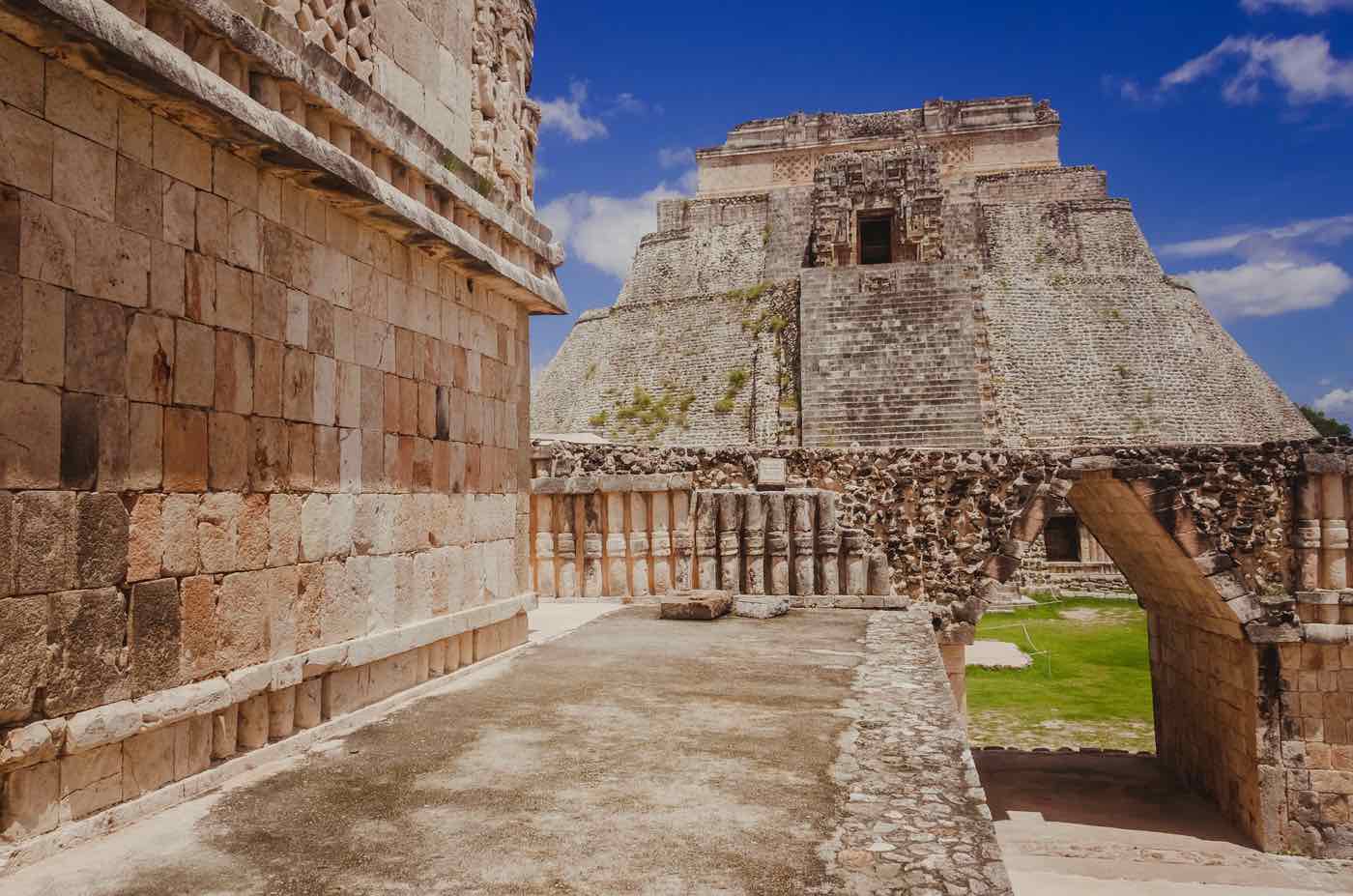
If there’s a country that will please any history buffs, it’s Mexico. Before the conquistadores arrive at the country in the 16th century – a devastating yet fascinating tale by itself – the country was Mayan and Aztec territory.
This incredible rich history still shows through its culture and food, which is particularly evident in the Yucatán region. Throughout the country, there are various imponent archaeological sites and ruins worth to visit. The most popular by far is Chichen Itza , but many say it’s overrated, overpriced, and overcrowded compared to other options.
- Chichen Itza close to Valladolid
- Cholula Pyramid close to Puebla
- Coba close to Tulum
- Ek Balam close to Valladolid
- Templo Mayor in Mexico City
- Teotihuacán close to Mexico City
- Tulum Ruins in Tulum
- Uxmal close to Mérida
16 Try to avoid tours
If you book a trip to Cancun or Playa del Carmen and hope to see the rest of the country booking guided tours, you’re set to see nothing but other tourists the entire time. Where is the fun in that?
Quite frankly, you’re much better off going off the beaten path. Explore the local, beautiful, authentic Mexico. Give yourself a chance to immerse in the local culture, with no deadlines or time restrictions. Your travel experience will greatly increase.
Personally, I don’t book tours unless it’s mandatory or it’s a cooking class. In Mexico, I used a 100% independent itinerary .
17 Learn basic Spanish
Mexico are used to have English-speaking tourists, but especially in smaller towns, it’s always good to master some Spanish words and expressions. It will both help connect with locals – only a small percentage of them speak fluent English – but you’re guaranteed to get a smile in return.
Basic Spanish words and expressions for travelers 🗣
- 🗣 Hello – Hola
- 🗣 Thank you – Gracias/Muchas gracias
- 🗣 Excuse me/Sorry – Perdón
- 🗣 What’s your name? – Como se llama usted?
- 🗣 My name is… – Mi nombre es…
18 Connect with locals.
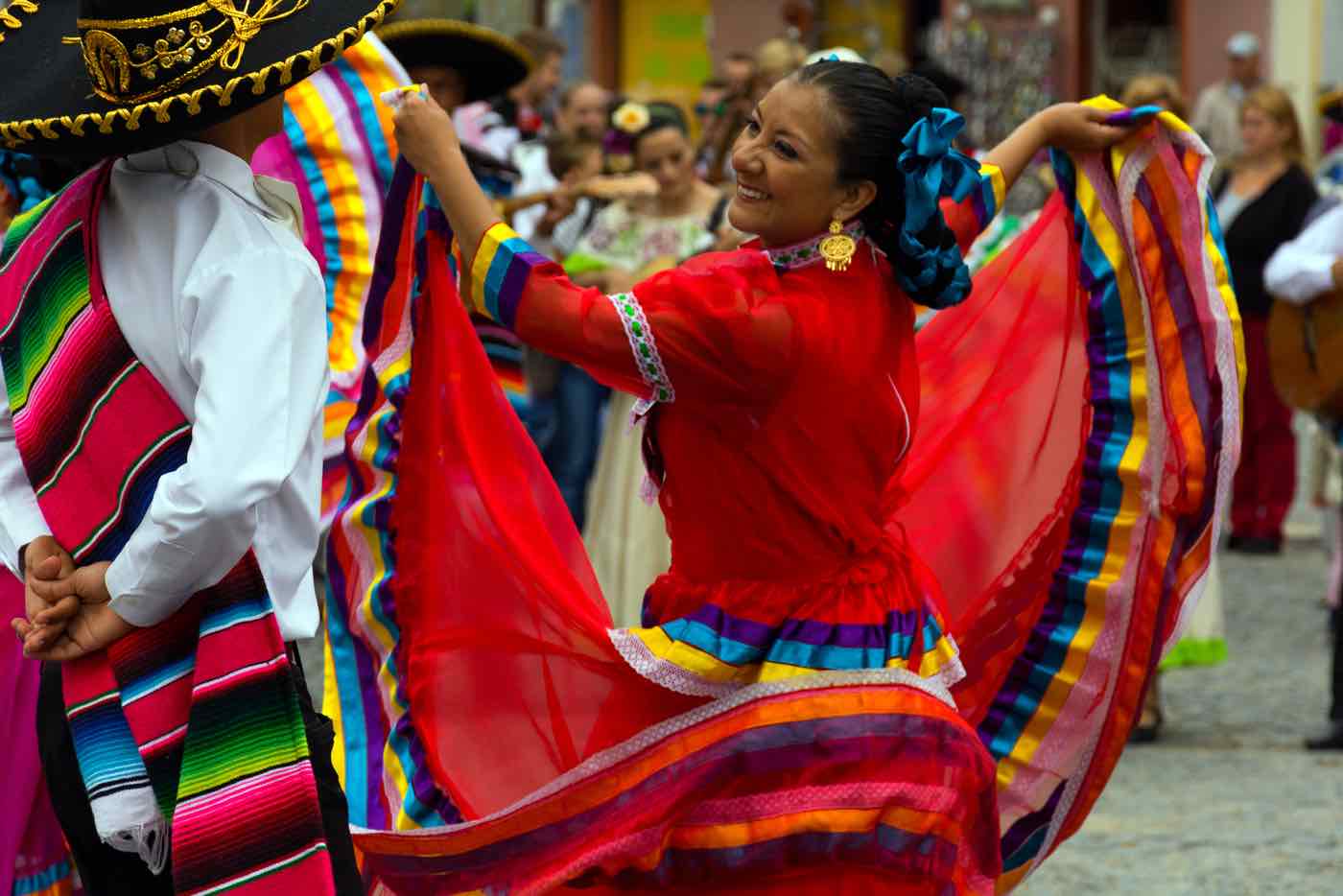
Honestly, the landscapes are beautiful, the history is fascinating, the food is delicious, but the Mexican people are a whole another level.
No matter what magnates with an orange face and crappy hair tell you, Mexicans are lively, friendly happy, with a constant smile on their faces that is contagious. Don’t be afraid to ask questions, make some joyful comments, and join the party whenever there’s one. They’ll win you over. A bit of Spanish can be helpful though.
19 Avoid the tap water
It’s generally a good idea to avoid tap water in Mexico. This obviously includes ice cubes in drinks and juices. If anything, in restaurants ask for agua del filtro .
Bring a bottle of water and reuse it when you find a agua filtrada (filtered water) or just bring a water purifier that filters the waer form the tap. Win for you, win for the environment.
20 Stay connected with a Telcel SIM card
More and more, I feel getting access to Internet abroad is important. Not to check your like count on Instagram or Facetime your friends, but to know where you are and research what’s around you.
While WiFi is available in malls, restaurants, and hotels, it’s a good idea to get a SIM card.
If you have a phone with eSIM capability – e.g. the new iPhones – you can purchase a virtual SIM card from Airalo (use BRUN03584 code for $3 credit!) and get immediately connected.
Otherwise, just head to a local OXXO store and ask for a physical TelCel SIM card. You can also get them in official Telcel stores. To save some money, you can use only one card and share the internet through a mobile WiFi router.

HUAWEI E5577s-321 Mobile WiFi Router
Put any SIM card in the world inside and it will share the data across all your devices via WiFi (up to 10!). The battery lasts 12 hours of working. Can’t recommend it enough!
Do you have more Mexico travel tips? What other things we should know? Let me know about your experience.
You might also like these articles 💬
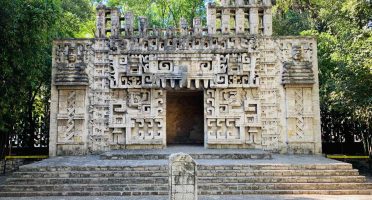
3 Days in Mexico City: Full Itinerary for First-Time Visitors
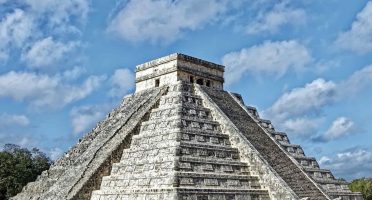
A First-Time Mexico Itinerary For a 100% Independent Trip
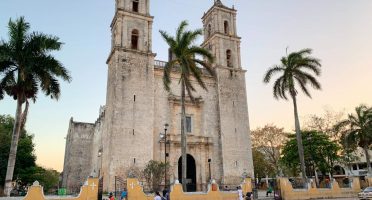
Valladolid, Mexico: A Complete Travel Guide

Destinations🌎

- Destinations
- North America
- Mexico City
A guide to Mexico for a first time visitor
By Erin Van Der Meer | 7 years ago
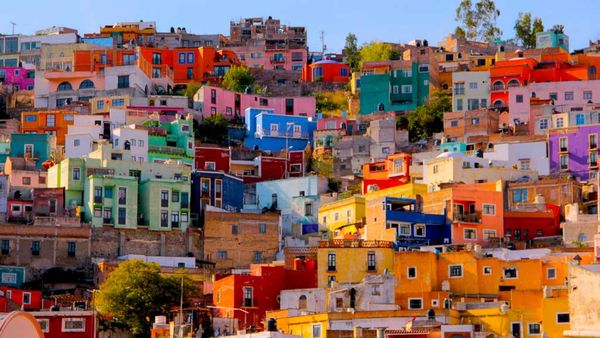
Mexico is one of the world's most exciting destinations and for those planning their first trip, our guide to Mexico helps to discover the best the country has to offer. From the pristine beaches of the Yucatan Peninsula to its thriving capital, here's your must-read Mexican guide.
Getting there and getting around
There are no direct flights to Mexico from Australia. The fastest route is via the US from Australia’s east coast, connecting in Los Angeles or Dallas. It’s also possible to fly to Tokyo, or a South American city such as Santiago, and then on to Mexico.
For stays of less than 180 days, Australians don’t need a visa for Mexico. But if you are travelling via the US you’ll need an ESTA (Electronic System for Travel Authorization) for passage through America – even if you’re not leaving the airport.
The ESTA can be purchased online and costs $14 US Dollars. Don’t be fooled by official looking scam websites that mimic the real website – this is the correct one .
Mexico City is the country’s capital and where most international flights arrive. From Mexico City International Airport there are connecting flights to pretty much anywhere in the country. Cancun International Airport will be more convenient if you want to start your trip in the Yucatan Peninsula or if you’re only visiting that region.
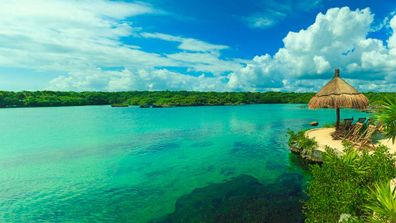
The stunning beaches in Yucatan Peninsula, Getty
For first-time visitors, flying is the easiest way to get around Mexico. Most routes are reasonably priced depending on when and where you’re going, and for non-Spanish speakers it’s the most stress-free option since most airline staff can speak English (as do most hotel staff, tour guides and other tourist industry professionals).
If you’re more adventurous, on a budget or not rushed for time, Mexico is serviced by an expansive bus network – ADO is the country’s primary bus line. There are other companies, but ADO’s fleet of coaches has a reputation as the cleanest, safest and most efficient. Bus travel in Mexico is mostly safe and comfortable, although to be extra cautious avoid travelling at night, as armed hold-ups of buses have happened.
Depending on what part of the country you’re in, hiring a car is also an option. Many major car hire companies such as Hertz and Europcar service Mexico. However, driving could be dangerous for non-Spanish speakers in the event of getting lost, and off the main highways roads can be potholed and poorly sign-posted.
Currency, money and costs
The current exchange rate for the Australian Dollar to the Mexican Peso is 1 = 13. Mexico is a good value tourist destination for Australians; for example, a beer in a bar in Mexico costs on average 25 – 40 pesos (AUD $1.80 – $2.90). However, prices in Mexico can vary dramatically. At some high-end resorts and in key tourist areas like Cancun, expect to pay similar prices to home for rooms, restaurants and more.
ATMs and currency exchanges can be found in most parts of Mexico. Bank cards are widely accepted, but if you’re a little off the beaten path it’s a good idea to carry cash. Call your bank before you leave to make sure your card will work in Mexico, or you can also load a travel card with Mexican currency. US dollars are sometimes accepted in areas frequented by tourists such as Cancun and Cabo San Lucas.
There are some parts of Mexico that experience high levels of crime and violence, but they are not anywhere near the places that most tourists visit.
“The major tourist destinations are free of the drug gang violence you’ve see on the news,” travel safety expert Phil Sylvester from travelinsurancedirect.com.au recently told 9Honey Travel.
The areas to avoid include some states on the US border, certain parts of some states on the Pacific coast and the former vacation town Acapulco. The Australian government’s Smart Traveller website has more information on the places to avoid.
In Mexico’s tourist destinations there are the same risks as anywhere – mainly petty theft and pickpocketing. Criminals tend to target people who seem vulnerable, so be aware and alert at all times – don’t drink too much, as being inebriated might make you an easy target.
Use common sense: avoid walking in unfamiliar areas late at night or accepting unsolicited offers of help from strangers, leave valuables such as flashy jewellery at home, and keep an eye on phones and expensive cameras.
Must-see destinations
There are so many incredible corners of Mexico that it's hard to choose which places to visit on a short holiday. But in two or three weeks you can get a good introduction.
Many first-time visitors to Mexico City are surprised at how cosmopolitan it is. The museums and art galleries showcasing a mix of ancient, indigenous and contemporary works are world-class, and the dining scene rivals that of any city.
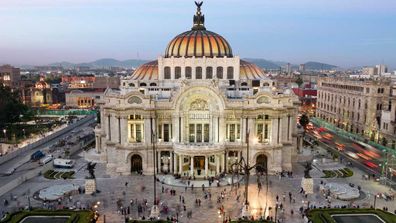
Palacio de Bellas Artes in Mexico City
You'll want to stay in the chic neighbourhood Condesa , which is close to the sights of the Centro Historico but offers a more authentic experience. Allow at least three days to explore.
Oaxaca, a small city a one-hour flight south of Mexico City, is beloved for its cobblestone streets, colourful buildings and unique cuisine. You’ll want to spend a few days sampling the tamales (steamed dough with delicious fillings) and the seven moles (pronounced ‘mo-lays’), sauces with distinctly different flavours.
As well as wandering the markets, art galleries and admiring the Spanish colonial architecture, take a day trip to Hierve el Agua, the mountain-top natural swimming holes. Quinta Real Oaxaca is a beautiful boutique hotel with a pool in the heart of the city.
No trip to Mexico would be complete without visiting the Yucatan Peninsula, a treasure chest of ancient Mayan ruins, cenotes (natural swimming holes) and of course, postcard-perfect Caribbean beaches.
Mega-resort strip Cancun has a buzzing atmosphere and exciting nightlife, while Tulum 90 minutes south is a sleepy beach town on the edge of the jungle, a row of eco-chic boutique hotels and rustic restaurants on the beach.
Playa Del Carmen, which is halfway between and has a glamorous, European vibe. Just forty minutes by ferry from Playa Del Carmen is Cozumel, an idyllic island with some of the best scuba diving in the region.
- Things To Do
Property News: There is a one of a kind room in this Sydney mansion.

Travel website Sami Lukis 'cannot live without' when booking a flight

Beyond the beach: exploring the other side of the Whitsundays

Australian locations that offer the best sunset and sunrise views
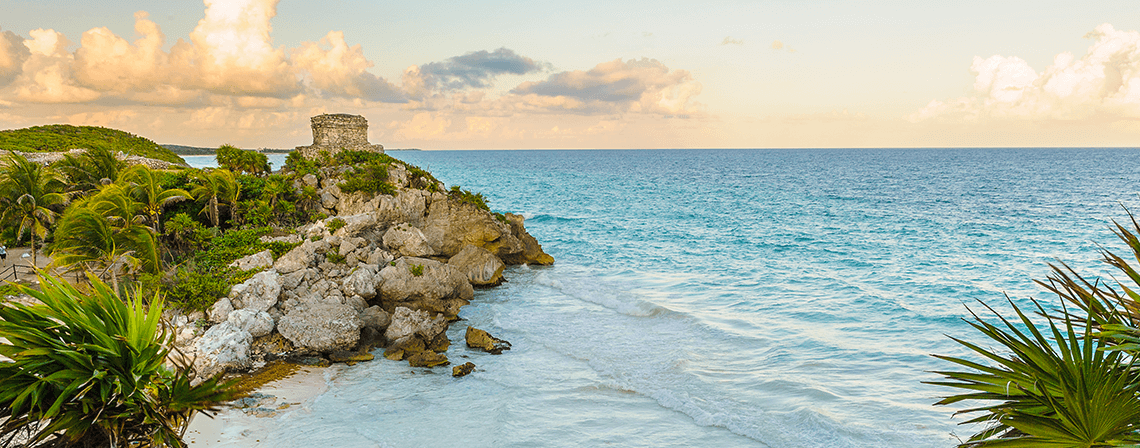
- You are here:
- Destinations
The warmth of the Mexican people combined with Ancient Mayan History, rich culture and natural treasures make Mexico the perfect vacation destination. Mexico is the second most visited country in the Americas. The Riviera Maya, from Cancun to Tulum, boasts powdery white sand beaches, Mayan archeological sites and mysterious cenotes and underground rivers. Cancun is one of the world’s most popular tourist destinations due to its world class dining and shopping, activities and tours, nightclubs and bars and turquoise blue Caribbean waters.
Quick Facts: Capital: Mexico City / Currency: Mexican Peso (MXN) / Official Language: Spanish / Country Code: +52 / Time Zone: UTC -5 (Cancun)

Royalton Riviera Cancun, An Autograph Collection All-Inclusive Resort & Casino
Royalton Riviera Cancun is a modern luxury resort in the popular vacation destination of Cancun. This new-generation all-inclusive hotel offers discerning travelers a family-friendly vacation experience, where guests of all ages are captivated from morning to night.
For families, an enormous on-site splash park, supervised kid’s and teen’s clubs and non-motorized water sports ensure that afternoons are filled with unforgettable moments. For guests of any age, Royalton signature All-In Luxury® features bring Unlimited Reservation-Free Dining, modern upscale accommodations, All-In Connectivity™ with free high-speed Wi-Fi for all your devices, in-room Bluetooth speakers, and free calls to select countries.

Hideaway at Royalton Riviera Cancun, An Autograph Collection All-Inclusive Resort - Adults Only
Hideaway at Royalton Riviera Cancun provides an All-In Luxury® vacation oasis for adults with elevated privacy, enhanced quality of service and complimentary extras like afternoon hors d’oeuvres and sunset toasts. Guests are offered private beach areas, adults-only pool and sunbathing areas plus in-room amenities like aromatherapy and pillow menus.
Savor gourmet cuisine, sip artfully prepared cocktails and enjoy the impossibly blue ocean, doing as much or as little as you’d like.
Delight in the freedom of spontaneity with the perfect mix of daily water sports, fitness programs, yoga on the beach, mixology classes beside the pool and unforgettable evenings of sunset champagne toasts, world-class dining and incomparable entertainment.

Royalton CHIC Cancun, An Autograph Collection All-Inclusive Resort - Adults Only
Welcome to spectacular Cancun, Mexico, and one of the most popular locations for beachfront getaways and an unrivaled nightlife. Royalton CHIC Cancun Resort & Spa, located in the famous hotel zone offering exceptional service, stylish architecture and incredible food for Adults +18. Spend your days lounging on the stunning, white sand beach next to breathtaking blue waters, and your nights celebrating under the stars overlooking the ocean and the Cancun strip at the adults only SkyClub - exclusive rooftop pool and cabanas.
Part of any vacation is the travel time to your destination. We’ve found that you can go from the airport to our resort in only 30 minutes.

Planet Hollywood Adult Scene Cancun, An Autograph Collection All-Inclusive Resort - Adults Only
Vacation Like A Star™ at the first-ever all-inclusive Planet Hollywood Adult Scene! Get close to authentic Hollywood memorabilia and enjoy themed experiences in a lavish haven for adults, with private beach and pool areas, exclusive check-in and check-out, and the ultimate experience of exploring global haute cuisine.

Planet Hollywood Cancun, An Autograph Collection All-Inclusive Resort
Vacation like a Star™ at all-new Planet Hollywood Beach Resorts. Guests of all ages can get close to authentic Hollywood memorabilia and enjoy themed experiences. Guests can choose from a variety of luxury suites, dining venues, incredible entertainment and bars or indulge in extra services at the Spa.

Mystique Holbox by Royalton, A Tribute Portfolio Resort
Mystique Blue Holbox, a contemporary, luxurious, and exquisite boutique beachfront resort is located on the exotic Holbox Island. The small paradisiac 26-mile island within Yum Balam is a protected nature reserve north of Mexico’s Yucatán Peninsula. Holbox is considered an exclusive destination unspoiled by mass tourism. Rich in marine life and a variety of endemic and migratory birds, guests will observe yellow-lord parrots, painted buntings, and flamingos.
Royalton Splash Riviera Cancun, An Autograph Collection All-Inclusive Resort
Dive into a world of all-inclusive family fun at Royalton Splash Riviera Cancun. Amplify your afternoons at one of the largest on-site water parks in the Caribbean. Dine and delight in any of our modern culinary offerings, play laser tag, or indulge in a pampering spa treatment while your little ones explore the dedicated kids club. There are so many ways to play in Cancun.
All Inclusive Mexico Resort Vacations
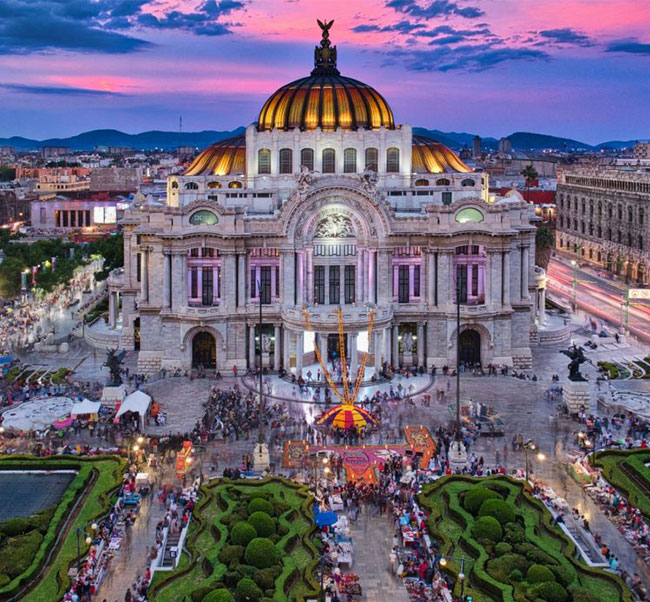
An all inclusive resort vacation allows you to truly stick to your vacation budget. You can learn to windsurf, go snorkeling, maybe take a dance lesson, play beach volleyball, or maybe just take it easy and simply slide up to the pool bar and enjoy a local rum concoction and a shrimp cocktail.
You're at an all inclusive resort - you can try anything you like for free at the resort. You can also leave the resort anytime you wish to explore Mexico and enjoy the local flavors and culture.
Maybe your all inclusive dream vacation is just about relaxing. That's included! Want to roll out of bed and onto the beach, lounging under a brightly colored beach umbrella until the sun sets into the Western sky? Then, an all inclusive Mexico resort vacation is ideal for you, with no worries about rental cars, taxis, hotels or restaurant reservations.
All inclusive Mexico resort vacations are also ideal for people who do want to try everything: golf, tennis, snorkeling, scuba diving, sailing, windsurfing, and maybe even parasailing. An all inclusive Mexico resort vacation is just right for people on tight budgets, too. You know exactly how much money to set aside for your entire vacation. And, all inclusive resorts come in all price ranges so you can find the one that is best for your budget.
There are Mexico all inclusive resorts that are ideal for singles, couples and family vacations, where the amenities and supervised activities available for the kids truly allow mom and dad to get some private romantic time alone. There are even all inclusive resorts that offer spectacular wedding and/or honeymoon packages. All inclusive resorts provide the most stress free vacations - you never have to worry about how you're going to pay your credit cards when you get back, or worry about money or tipping or anything else - you've already paid for everything and it's all included! That's why people like all inclusive Mexico resort vacations.
Be a Smart Traveler!
© 1995-2024 Smart Traveler All Rights Reserved

We connect you to FREE travel experts to help save you time and money on Hotels Cruises Cars Tours Airfares Shore Excursions Travel Insurance & more!
- Travel Advisories |
- Contact Us |
- MyTravelGov |
Find U.S. Embassies & Consulates
Travel.state.gov, congressional liaison, special issuance agency, u.s. passports, international travel, intercountry adoption, international parental child abduction, records and authentications, popular links, travel advisories, mytravelgov, stay connected, legal resources, legal information, info for u.s. law enforcement, replace or certify documents.
Share this page:
Mexico Travel Advisory
Travel advisory september 6, 2024, mexico - see state summaries.
Reissued after periodic review with updates for Chiapas, and Durango.
Country Summary: Violent crime – such as homicide, kidnapping, carjacking, and robbery – is widespread and common in Mexico. The U.S. government has limited ability to provide emergency services to U.S. citizens in many areas of Mexico, as travel by U.S. government employees to certain areas is prohibited or restricted. In many states, local emergency services are limited outside the state capital or major cities.
U.S. citizens are advised to adhere to restrictions on U.S. government employee travel. State-specific restrictions are included in the individual state advisories below. U.S. government employees may not travel between cities after dark, may not hail taxis on the street, and must rely on dispatched vehicles, including app-based services like Uber, and regulated taxi stands. U.S. government employees should avoid traveling alone, especially in remote areas. U.S. government employees may not drive from the U.S.-Mexico border to or from the interior of Mexico, except daytime travel within Baja California and between Nogales and Hermosillo on Mexican Federal Highway 15D, between Nuevo Laredo and Monterrey on Highway 85D and between Ciudad Juarez and interior cities as noted in the Chihuahua section. Read the country information page for additional information on travel to Mexico.
Do Not Travel To:
- Colima state due to crime and kidnapping .
- Guerrero state due to crime .
- Michoacan state due to crime .
- Sinaloa state due to crime .
- Tamaulipas state due to crime and kidnapping.
- Zacatecas state due to crime and kidnapping .
Reconsider Travel To:
- Baja California state due to crime and kidnapping .
- Chiapas state due to crime .
- Chihuahua state due to crime and kidnapping .
- Guanajuato state due to crime .
- Jalisco state due to crime and kidnapping .
- Morelos state due to crime and kidnapping .
- Sonora state due to crime and kidnapping .
Exercise Increased Caution When Traveling To:
- Aguascalientes state due to crime .
- Baja California Sur state due to crime .
- Coahuila state due to crime .
- Durango state due to crime .
- Hidalgo state due to crime .
- Mexico City due to crime .
- Mexico State due to crime and kidnapping .
- Nayarit state due to crime .
- Nuevo Leon state due to crime .
- Oaxaca state due to crime .
- Puebla state due to crime and kidnapping .
- Queretaro state due to crime .
- Quintana Roo state due to crime .
- San Luis Potosi state due to crime and kidnapping .
- Tabasco state due to crime .
- Tlaxcala state due to crime .
- Veracruz state due to crime .
Exercise Normal Precautions When Traveling To:
- Campeche state
- Yucatan state
Visit our website for Travel to High-Risk Areas .
If you decide to travel to Mexico:
- Keep traveling companions and family back home informed of your travel plans. If separating from your travel group, send a friend your GPS location. If taking a taxi alone, take a photo of the taxi number and/or license plate and text it to a friend.
- Use toll roads when possible and avoid driving alone or at night. In many states, police presence and emergency services are extremely limited outside the state capital or major cities.
- Exercise increased caution when visiting local bars, nightclubs, and casinos.
- Do not display signs of wealth, such as wearing expensive watches or jewelry.
- Be extra vigilant when visiting banks or ATMs.
- Enroll in the Smart Traveler Enrollment Program (STEP) to receive Alerts and make it easier to locate you in an emergency.
- Follow the Department of State on Facebook and X/Twitter .
- Follow the U.S. Embassy on Facebook and X/Twitter .
- Review the Country Security Report for Mexico.
- Mariners planning travel to Mexico should check for U.S. maritime advisories and alerts , which include instructions on reporting suspicious activities and attacks to Mexican naval authorities.
- Prepare a contingency plan for emergency situations. Review the Traveler’s Checklist .
- Visit the CDC page for the latest travel health information related to your travel.
Aguascalientes state – Exercise Increased Caution
Exercise increased caution due to crime.
Criminal activity and violence may occur throughout the state.
There are no restrictions on travel for U.S. government employees in Aguascalientes state.
Baja California state – Reconsider Travel
Reconsider travel due to crime and kidnapping.
Transnational criminal organizations compete in the border area to establish narco-trafficking and human smuggling routes. Violent crime and gang activity are common. Travelers should remain on main highways and avoid remote locations. Of particular concern is the high number of homicides in the non-tourist areas of Tijuana. Most homicides appeared to be targeted; however, criminal organization assassinations and territorial disputes can result in bystanders being injured or killed. U.S. citizens and LPRs have been victims of kidnapping.
U.S. government employees must adhere to the noted restrictions:
- Mexicali Valley: U.S. government employees should avoid the Mexicali Valley due to the heightened possibility of violence between rival cartel factions. The boundaries of the restricted area are: to the east, the Baja California/Arizona and Baja California/Sonora borders; to the south, from La Ventana (on Highway 5) due east to the Colorado River; to the west, Highway 5; and to the north, Boulevard Lazaro Cardenas/Highway 92/Highway 1 to Carretera Aeropuerto, from the intersection of Highway 1 and Carretera Aeropuerto due north to the Baja California/California border, and from that point eastward along the Baja California/California border.
- Travelers may use Highways 2 and 2D to transit between Mexicali, Los Algodones, and San Luis Rio Colorado during daylight hours. Travelers may also use Highways 1 and 8 to transit to and from the Mexicali Airport during daylight hours. Travel on Highway 5 is permissible during daylight hours.
To view a map of the restricted areas, visit https://mx.usembassy.gov/maps-of-restricted-areas There are no other travel restrictions for U.S. government employees in Baja California state. These include high-traffic tourism areas of border and coastal communities, such as Tijuana , Ensenada , and Rosarito .
Baja California Sur state – Exercise Increased Caution
There are no restrictions on travel for U.S. government employees in Baja California Sur state.
Campeche state – Exercise Normal Precautions
Exercise normal precautions.
There are no restrictions on travel for U.S. government employees in Campeche state.
Chiapas state – Reconsider Travel
Reconsider travel due to crime.
U.S. government employees may not travel to the municipality of Ocozocoautla and to the following restricted areas in the southeastern region. All areas within the boundaries, including highway and roads unless specifically exempted, are restricted. East-Northeast Boundary: the eastern boundary follows the Mexican-Guatemalan border from the southern point on the Pacific coast, along the border, to the northern end point east of Netzahualcóyotl. Northern Boundary: from Netzahualcóyotl in a straight line southwest towards the northern limit of Ocosingo. Western Boundary: from Ocosingo in a straight-line south to El Ocote, from El Ocote in a straight-line west to San Francisco Pujiltic, from San Franciso Pujiltic southwest to just north of Mapastepec. South-Southwest Boundary: Highway 200 from Mapastepec to Tapachula. All towns along this highway are not restricted. The area to the north of highway 200 defines the southern boundary of the restricted area. From Tapachula, the restricted area boundary is north and east of the city limits and then extends southeast to the Pacific coast at Tres Hermanos San Isidro.
U.S. government employees may travel to Tapachula within the city limits and on Highway 225, from Port Chiapas to Tapachula, including the Tapachula Airport.
To view a map of the restricted areas, visit https://mx.usembassy.gov/maps-of-restricted-areas
Chihuahua state – Reconsider Travel
Violent crime and gang activity are common. Most homicides are targeted assassinations against members of criminal organizations. Battles for territory between criminal groups have resulted in violent crime in areas frequented by U.S. citizens and U.S. government employees, including restaurants and malls during daylight hours. Bystanders have been injured or killed in shooting incidents. U.S. citizens and LPRs have been victims of kidnapping.
U.S. government employee travel is limited to the following areas with the noted restrictions:
- Ciudad Juarez: U.S. government employees may travel to the area of Ciudad Juarez bounded to the east by Bulevar Independencia; to the south by De los Montes Urales/Avenida Manuel J Clouthier/Carretera de Juárez; to the west by Via Juan Gabriel/Avenida de los Insurgentes/Calle Miguel Ahumada/Francisco Javier Mina/Melchor Ocampo; and to the north by the U.S.-Mexico border. Direct travel to the Ciudad Juarez airport (officially called the Abraham González International Airport) and the factories located along Bulevar Independencia and Las Torres is permitted. Travel to San Jerónimo is permitted only through the United States via the Santa Teresa U.S. Port of Entry; travel via Anapra is prohibited.
U.S. government employees may only travel from Ciudad Juarez to the city of Chihuahua during daylight hours via Federal Highway 45, with stops permitted only at the Guardia Nacional División Caminos station, the Umbral del Milenio overlook area, the border inspection station at KM 35, and the shops and restaurants on Federal Highway 45 in the city of Ahumada.
- U.S. government employees may travel between Ciudad Juarez and Ascension via Highway 2.
- Nuevo Casas Grandes Area (including Nuevo Casas Grandes, Casas Grandes, Mata Ortiz, Colonia Juárez, Colonia LeBaron, Paquimé and San Buenaventura): U.S. government employees may travel to the Nuevo Casas Grandes area during daylight hours via Mexico Federal Highway 2, and subsequently Federal Highway 10, to Nuevo Casas Grandes. Employees are permitted to stay overnight in the cities of Nuevo Casas Grandes and Casas Grandes only.
- City of Chihuahua: U.S. government employees may travel at any time to the area of the city of Chihuahua bounded to the north by Avenida Transformación; to the east by Avenida Tecnológico/Manuel Gómez Morín/Highway 16/Blvd.José Fuentes Mares; to the west by the city boundary; and to the south by Periférico Francisco R. Almada.
- U.S. government employees may travel on Highways 45, 16, and 45D through the city of Chihuahua and to the Chihuahua airport (officially called the General Roberto Fierro Villalobos International Airport).
- U.S. government employees may travel to Santa Eulalia to the east of the city of Chihuahua, as well as to Juan Aldama via Highway 16 to the northeast.
- U.S. government employees may travel south of the city of Chihuahua on Highway 45 to the southern boundary of Parral, including each town directly connected to Highway 45, including Lázaro Cárdenas, Pedro Meoqui, Santa Cruz de Rosales, Delicias, Camargo, Ciudad Jiménez, and Parral itself.
- U.S. government employees may only travel on official business from the city of Chihuahua on Highway 16 to Ciudad Cuauhtémoc bounded by Highway 21 to the north and east, Highway 5 to the west, and Bulevar Jorge Castillo Cabrera to the south.
- Ojinaga: U.S. government employees must travel to Ojinaga via U.S. Highway 67 and enter through the U.S. Port of Entry in Presidio, Texas.
- Palomas: U.S. government employees may travel to Palomas via U.S. highways through the U.S. Port of Entry in Columbus, New Mexico, or via Highway 2 in Mexico.
To view a map of the restricted areas, visit https://mx.usembassy.gov/maps-of-restricted-areas U.S. government employees may not travel to other areas of Chihuahua, including Copper Canyon .
Coahuila state – Exercise Increased Caution
Violent crime and gang activity occur in parts of Coahuila state.
U.S. government employees must adhere to the following travel restrictions:
- Zaragoza, Morelos, Allende, Nava, Jimenez, Villa Union, Guerrero, and Hidalgo municipalities : U.S. government employees may not travel to these municipalities.
- Piedras Negras and Ciudad Acuña: U.S. government employees must travel directly from the United States and observe a curfew from midnight to 6:00 a.m. in both cities.
To view a map of the restricted areas, visit https://mx.usembassy.gov/maps-of-restricted-areas There are no other restrictions on travel for U.S. government employees in Coahuila state.
Colima state – Do Not Travel
Do not travel due to crime and kidnapping.
Violent crime and gang activity are widespread. Most homicides are targeted assassinations against members of criminal organizations. Shooting incidents between criminal groups have injured or killed bystanders. U.S. citizens and LPRs have been victims of kidnapping.
Travel for U.S. government employees is limited to the following areas with noted restrictions:
- Manzanillo: U.S. government employee travel is limited to the tourist and port areas of Manzanillo.
- Employees traveling to Manzanillo from Guadalajara must use Federal Toll Road 54D during daylight hours.
To view a map of the restricted areas, visit https://mx.usembassy.gov/maps-of-restricted-areas U.S. government employees may not travel to other areas of Colima state.
Durango state – Exercise Increased Caution
Violent crime and gang activity are common in parts of Durango state.
- West and south of Federal Highway 45: U.S. government employees may not travel to this region of Durango state.
To view a map of the restricted areas, visit https://mx.usembassy.gov/maps-of-restricted-areas There are no other restrictions on travel for U.S. government employees in Durango state.
Guanajuato state – Reconsider Travel
Gang violence, often associated with the theft of petroleum and natural gas from the state oil company and other suppliers, occurs in Guanajuato, primarily in the south and central areas of the state. Of particular concern is the high number of murders in the southern region of the state associated with cartel-related violence. U.S. citizens and LPRs have been victims of kidnapping.
- Areas south of Federal Highway 45D: U.S. government employees may not travel to the area south of and including Federal Highway 45D, Celaya, Salamanca, and Irapuato.
To view a map of the restricted areas, visit https://mx.usembassy.gov/maps-of-restricted-areas There are no other restrictions on travel for U.S. government employees in Guanajuato state, which includes tourist areas in: San Miguel de Allende , Guanajuato City , and surrounding areas.
Guerrero state – Do Not Travel
Do not travel due to crime.
Crime and violence are widespread. Armed groups operate independently of the government in many areas of Guerrero. Members of these groups frequently maintain roadblocks and may use violence towards travelers. U.S. citizens and LPRs have been victims of kidnapping in previous years.
U.S. government employees may not travel to any area in the state of Guerrero, including to tourist areas in Acapulco , Zihuatanejo , Taxco , and Ixtapa .
Hidalgo state – Exercise Increased Caution
There are no restrictions on travel for U.S. government employees in Hidalgo state.
Jalisco state – Reconsider Travel
Violent crime and gang activity are common in parts of Jalisco state. In Guadalajara, territorial battles between criminal groups take place in tourist areas. Shooting incidents between criminal groups have injured or killed innocent bystanders. U.S. citizens and LPRs have been victims of kidnapping.
- Jalisco-Michoacan border and Federal Highway 110: U.S. government employees may not travel to the area between Federal Highway 110 and the Jalisco-Michoacan border, nor travel on Federal Highway 110 between Tuxpan, Jalisco, and the Michoacan border.
- Federal Highway 80: U.S. government employees may not travel on Federal Highway 80 south of Cocula.
To view a map of the restricted areas, visit https://mx.usembassy.gov/maps-of-restricted-areas There are no other restrictions on travel for U.S government employees in Jalisco state which includes tourist areas in: Guadalajara Metropolitan Area , Puerto Vallarta (including neighboring Riviera Nayarit) , Chapala , and Ajijic .
Mexico City (Ciudad de Mexico) – Exercise Increased Caution
Both violent and non-violent crime occur throughout Mexico City. Use additional caution, particularly at night, outside of the frequented tourist areas where police and security patrol more routinely. Petty crime occurs frequently in both tourist and non-tourist areas.
There are no restrictions on travel for U.S. government employees in Mexico City.
Mexico State (Estado de Mexico) – Exercise Increased Caution
Exercise increased caution due to crime and kidnapping.
Both violent and non-violent crime occur throughout Mexico State. Use additional caution in areas outside of the frequented tourist areas, although petty crime occurs frequently in tourist areas as well. U.S. citizens and LPRs have been victims of kidnapping. There are no restrictions on travel for U.S. government employees in Mexico State.
Michoacan state – Do Not Travel
Do not travel due to crime and kidnapping.
Crime and violence are widespread in Michoacan state. Travel for U.S. government employees is limited to the following areas with the noted restrictions:
- Federal Highway 15D: U.S. government employees may travel on Federal Highway 15D to transit the state between Mexico City and Guadalajara.
- Morelia: U.S. government employees may travel by air and by land using Federal Highways 43 or 48D from Federal Highway 15D.
- Lazaro Cardenas: U.S. government employees must travel by air only and limit activities to the city center or port areas.
To view a map of the restricted areas, visit https://mx.usembassy.gov/maps-of-restricted-areas U.S. government employees may not travel to other areas of the state of Michoacan, including the portions of the Monarch Butterfly Reserve located in Michoacan.
Morelos state – Reconsider Travel
Reconsider travel due to crime and kidnapping.
Violent crime and gang activity are common in parts of Morelos state. U.S. citizens and LPRs have been victims of kidnapping.
There are no restrictions on travel for U.S. government employees in Morelos state.
Nayarit state – Exercise Increased Caution
Criminal activity and violence may occur throughout Nayarit state.
There are no restrictions on travel for U.S government employees in Nayarit state.
Nuevo Leon state – Exercise Increased Caution
Criminal activity and violence may occur throughout the state. There are no restrictions on travel for U.S. government employees in Nuevo Leon state.
Oaxaca state – Exercise Increased Caution
Criminal activity and violence occur throughout the state.
U.S. travelers are reminded that U.S. government employees must adhere to the following travel restrictions:
- Isthmus region: U.S. government employees may not travel to the area of Oaxaca bounded by Federal Highway 185D to the west, Federal Highway 190 to the north, and the Oaxaca-Chiapas border to the east. This includes the cities of Juchitan de Zaragoza, Salina Cruz, and San Blas Atempa.
- Federal Highway 200 northwest of Pinotepa: U.S. government employees may not use Federal Highway 200 between Pinotepa and the Oaxaca-Guerrero border.
To view a map of the restricted areas, visit https://mx.usembassy.gov/maps-of-restricted-areas There are no restrictions on travel for U.S. government employees to other parts of Oaxaca state, which include tourist areas in: Oaxaca City , Monte Alban , Puerto Escondido, and Huatulco .
Puebla state – Exercise Increased Caution
Exercise increased caution due to crime and kidnapping.
Criminal activity and violence may occur throughout the state. U.S. citizens and LPRs have been victims of kidnapping.
There are no restrictions on travel for U.S. government employees in Puebla state.
Queretaro state – Exercise Increased Caution
There are no restrictions on travel for U.S. government employees in Queretaro state.
Quintana Roo state – Exercise Increased Caution
Criminal activity and violence may occur in any location, at any time, including in popular tourist destinations. While not directed at tourists, shootings between rival gangs have injured and killed innocent bystanders, including U.S. citizens. Violent crime, including homicides and assaults, has increased in Tulum.
There are no restrictions on travel for U.S. government employees in Quintana Roo state. Exercise increased caution after dark in Cancun, Playa del Carmen, and Tulum and remain in well-lit pedestrian streets and tourist zones.
San Luis Potosi state – Exercise Increased Caution
There are no restrictions on travel for U.S. government employees in San Luis Potosi state.
Sinaloa state – Do Not Travel
Violent crime is widespread. Criminal organizations are based in and operating in Sinaloa.
Travel for U.S. government employees is limited to the following areas with the noted restrictions:
- Mazatlan: U.S. government employees may travel to Mazatlan by air or sea only, are limited to the Zona Dorada and historic town center, and must travel via direct routes between these destinations and the airport and sea terminal.
- Los Mochis and Topolobampo: U.S. government employees may travel to Los Mochis and Topolobampo by air or sea only, are restricted to the city and the port, and must travel via direct routes between these destinations and the airport.
To view a map of the restricted areas, visit https://mx.usembassy.gov/maps-of-restricted-areas U.S. government employees may not travel to other areas of Sinaloa state.
Sonora state – Reconsider Travel
Sonora is a key location used by the international drug trade and human trafficking networks. Violent crime is widespread. U.S. citizens and LPRs have been victims of kidnapping. Travelers should maintain a heightened level of awareness of their surroundings in all their travels in Sonora. Security incidents may occur in any area of Sonora.
- Travel between Hermosillo and Nogales: U.S. government employees may travel between the U.S. Ports of Entry in Nogales and Hermosillo during daylight hours via Federal Highway 15 only. U.S. government employees may not use ANY taxi services, public buses, nor ride-share applications due to a lack of secure vetting and/or dispatching procedures. Travelers should exercise caution and avoid unnecessary stops as security incidents, including sporadic, armed carjackings, and shootings have been reported along this highway during daylight hours. Travelers should have a full tank of gas and inform friends or family members of their planned travel.
- Nogales: U.S. government employees may not travel in the triangular area north of Avenida Tecnologico, west of Bulevar Luis Donaldo Colosio (Periferico), nor east of Federal Highway 15D (Corredor Fiscal). U.S. government employees also may not travel in the residential and business areas to east of the railroad tracks along Plutarco Elias Calle (HWY 15) and Calle Ruiz Cortino, including the business area around the Morley pedestrian gate port-of-entry. U.S. government employees may not use ANY taxi services, public buses, nor ride-share applications in Nogales due to a lack of secure vetting and/or dispatching procedures and the danger of kidnapping and other violent crimes.
- Puerto Peñasco: U.S. government employees may travel between Puerto Peñasco and the Lukeville-Sonoyta U.S. Port of Entry during daylight hours via Federal Highway 8 only. They may not travel on any other route to Puerto Peñasco. U.S. government employees may not use ANY taxi services, public buses, nor ride-share applications in Puerto Peñasco. due to a lack of secure vetting and/or dispatching procedures and the danger of kidnapping and other violent crimes.
- Triangular region near Mariposa U.S. Port of Entry: U.S. government employees may not travel into or through the triangular region west of the Mariposa U.S. Port of Entry, east of Sonoyta, and north of Altar municipality.
- San Luis Rio Colorado, Cananea, and Agua Prieta : U.S. government employees may travel directly from the nearest U.S. Port of Entry to San Luis Rio Colorado, Cananea (via Douglas Port of Entry), and Agua Prieta, but may not go beyond the city limits. Travel is limited to daylight hours only. Travel between Nogales and Cananea via Imuris is not permitted. U.S. government employees may not use ANY taxi services, public buses, nor ride-share applications in these cities due to a lack of secure vetting and/or dispatching procedures and the danger of kidnapping and other violent crimes.
- Eastern and southern Sonora (including San Carlos Nuevo Guaymas and Alamos): U.S. government employees may not travel to areas of Sonora east of Federal Highway 17, the road between Moctezuma and Sahuaripa, and State Highway 20 between Sahuaripa and the intersection with Federal Highway 16. U.S. government employees may travel to San Carlos Nuevo Guaymas and Alamos; travel to Alamos is only permitted by air and within city limits. U.S. government employees may not travel to areas of Sonora south of Federal Highway 16 and east of Federal Highway 15 (south of Hermosillo), as well as all points south of Guaymas, including Empalme, Guaymas, Obregon, and Navojoa. U.S. government employees may not use ANY taxi services, public buses, nor ride-share applications in these areas due to a lack of secure vetting and/or dispatching procedures and the danger of kidnapping and other violent crimes.
To view a map of the restricted areas, visit https://mx.usembassy.gov/maps-of-restricted-areas U.S. government employees may travel to other parts of Sonora state in compliance with the above restrictions, including tourist areas in: Hermosillo , Bahia de Kino , and Puerto Penasco .
Tabasco state – Exercise Increased Caution
There are no restrictions on travel for U.S. government employees in Tabasco state.
Tamaulipas state – Do Not Travel
Organized crime activity – including gun battles, murder, armed robbery, carjacking, kidnapping, forced disappearances, extortion, and sexual assault – is common along the northern border and in Ciudad Victoria. Criminal groups target public and private passenger buses, as well as private automobiles traveling through Tamaulipas, often taking passengers and demanding ransom payments.
Heavily armed members of criminal groups often patrol areas of the state and operate with impunity particularly along the border region from Reynosa to Nuevo Laredo. In these areas, local law enforcement has limited capacity to respond to incidents of crime. Law enforcement capacity is greater in the tri-city area of Tampico, Ciudad Madero, and Altamira, which has a lower rate of violent criminal activity compared to the rest of the state. U.S. citizens and LPRs have been victims of kidnapping. U.S. citizens and LPRs have been victims of kidnapping.
- Matamoros and Nuevo Laredo: U.S. government employees may only travel within a limited radius around and between the U.S. Consulates in Nuevo Laredo and Matamoros, their homes, the respective U.S. Ports of Entry, and limited downtown sites, subject to an overnight curfew.
- Overland travel in Tamaulipas: U.S. government employees may not travel between cities in Tamaulipas using interior Mexican highways. Travel between Nuevo Laredo and Monterrey is limited to Federal Highway 85D during daylight hours with prior authorization.
To view a map of the restricted areas, visit https://mx.usembassy.gov/maps-of-restricted-areas U.S. government employees may not travel to other parts of Tamaulipas state.
Tlaxcala state – Exercise Increased Caution
There are no restrictions on travel for U.S. government employees in Tlaxcala state.
Veracruz state – Exercise Increased Caution
Violent crime and gang activity occur with increasing frequency in Veracruz, particularly in the center and south near Cordoba and Coatzacoalcos. While most gang-related violence is targeted, violence perpetrated by criminal organizations can affect bystanders. Impromptu roadblocks requiring payment to pass are common. There are no restrictions on travel for U.S. government employees in Veracruz state.
Yucatan state – Exercise Normal Precautions
There are no restrictions on travel for U.S. government employees in Yucatan state, which include tourist areas in: Chichen Itza , Merida , Uxmal , and Valladolid .
Zacatecas state – Do Not Travel
Violent crime, extortion, and gang activity are widespread in Zacatecas state. U.S. citizens and LPRs have been victims of kidnapping.
- Zacatecas City : U.S. government employee travel is limited to Zacatecas City proper, and employees may not travel overland to Zacatecas City.
- U.S. government employees may not travel to other areas of Zacatecas state.
Travel Advisory Levels
Assistance for u.s. citizens, search for travel advisories, external link.
You are about to leave travel.state.gov for an external website that is not maintained by the U.S. Department of State.
Links to external websites are provided as a convenience and should not be construed as an endorsement by the U.S. Department of State of the views or products contained therein. If you wish to remain on travel.state.gov, click the "cancel" message.
You are about to visit:

IMAGES
COMMENTS
Australian Government travel advice for Mexico. Learn more about local safety, laws and health risks.
The latest research from the Department of Foreign Affairs and Trade's Smartraveller and Insurance Council of Australia shows Australians' common misunderstandings when it comes to travel insurance.
The Smart Traveler Enrollment Program (STEP) is a free service to allow U.S. citizens and nationals traveling and living abroad to enroll their trip with the nearest U.S. Embassy or Consulate. Receive important information from the Embassy about safety conditions in your destination country, helping you make informed decisions about your travel ...
Smart Traveler Enrollment Program (STEP) Are you traveling or living outside the U.S.? STEP is a free service that sends you emails with updates from the local U.S. embassy or consulate. If there's an emergency where you are, it helps us contact you with instructions on what to do.
Reissued after periodic review with updates for Chiapas, and Durango. Country Summary: Violent crime - such as homicide, kidnapping, carjacking, and robbery - is widespread and common in Mexico.The U.S. government has limited ability to provide emergency services to U.S. citizens in many areas of Mexico, as travel by U.S. government employees to certain areas is prohibited or restricted.
The Government of Mexico has issued a Hurricane Warning for the coast of the Yucatan Peninsula from Puerto Costa, including Cancun. STEP. The Smart Traveler Enrollment Program (STEP) is a free service to allow U.S. citizens and nationals traveling and living abroad to enroll their trip with the nearest U.S. Embassy or Consulate. Enroll a trip ...
The United States and Mexico entered a joint initiative March 21 restricting non-essential travel along the U.S.-Mexico land border to prevent the spread of the COVID-19 virus. Non-essential travel includes travel that is considered tourism or recreational in nature. These restrictions apply to travel in both directions across the border.
All international travelers should be fully vaccinated against measles with the measles-mumps-rubella (MMR) vaccine, including an early dose for infants 6-11 months, according to CDC's measles vaccination recommendations for international travel. Dogs infected with rabies are sometimes found in Mexico.
The Smart Traveler Enrollment Program (STEP) is a free service that enables U.S. citizens and nationals traveling and living abroad to enroll their trip with the nearest U.S. embassy or consulate. That way, they are able to quickly receive important information from the U.S. embassy about safety conditions in their destination country, which ...
The U.S. State Department's Bureau of Consular Affairs has created the Smart Traveler Enrollment Program (STEP) to help keep you up-to-date on relevant security updates from the nearest U.S. consulate.
Check out the Global Airport Rewards Programmes online at the Smart Traveller. Download our app today and get personalised e-membership .
The Smart Traveler Enrollment Program (STEP) is a free service to allow U.S. citizens and nationals traveling and living abroad to enroll their trip with the nearest U.S. Embassy or Consulate. Receive important information from the Embassy about safety conditions in your destination country, helping you make informed decisions about your travel ...
20 must-know Mexico travel tips. If you're heading to Mexico soon, this is what you need to know for a safe and worry-free trip.
Mexico Vacations - Mexico Vacation Packages, Cancun Vacations, Cabo San Lucas Vacations, All Inclusive Mexico Vacations, Mexican Travel, Mexican Vacations.
Staying Connected. There are a number of ways to receive updates to our safety and security information. Choose the one that is right for you. All Travel Advisories and Alerts. Smart Traveler Enrollment Program (STEP) Create an account at STEP.state.gov and provide the details of your specific trip, including dates of arrival and departure for ...
Is it safe to travel to Mexico? The Australian Government's Smart Traveller.gov.au safety advice is enough to make you want to cancel your flight - the words "violent crime" and "drug-related violence" don't exactly get you in the mood for a holiday.
The current exchange rate for the Australian Dollar to the Mexican Peso is 1 = 13. Mexico is a good value tourist destination for Australians; for example, a beer in a bar in Mexico costs on average 25 - 40 pesos (AUD $1.80 - $2.90). However, prices in Mexico can vary dramatically. At some high-end resorts and in key tourist areas like ...
Pack Smart Prepare a travel health kit with items you may need, especially those that may be difficult to find on your trip. If you have specific medical conditions, check with your healthcare professional for any additional items to consider bringing along.
Reserve. 8-day Smart-Inclusive from Cancun to Tulum, the Mayan Heritage Path. Ports of Call Tours. 3+ days. This is the most complete vacation package ever created. Combine your All-Inclusive vacations with immersive travel experiences…. from. $4,029. per adult.
Learn about Mexico's travel requirements, safety tips, and cultural attractions from the U.S. Department of State.
Mexico The warmth of the Mexican people combined with Ancient Mayan History, rich culture and natural treasures make Mexico the perfect vacation destination. Mexico is the second most visited country in the Americas. The Riviera Maya, from Cancun to Tulum, boasts powdery white sand beaches, Mayan archeological sites and mysterious cenotes and underground rivers. Cancun is one of the world's ...
All Inclusive Mexico Resort Vacations An all inclusive resort vacation allows you to truly stick to your vacation budget. You can learn to windsurf, go snorkeling, maybe take a dance lesson, play beach volleyball, or maybe just take it easy and simply slide up to the pool bar and enjoy a local rum concoction and a shrimp cocktail.
Smartravel México, Tuxtla Gutiérrez, Chiapas. 5,287 likes · 1 talking about this · 78 were here. Tu manera inteligente de viajar
Mexico Travel Advisory. Reissued after periodic review with updates for Chiapas, and Durango. Country Summary: Violent crime - such as homicide, kidnapping, carjacking, and robbery - is widespread and common in Mexico. The U.S. government has limited ability to provide emergency services to U.S. citizens in many areas of Mexico, as travel ...